Kvarner and Istria Residents Appeal to Slovenian Government to Change Entry Measures
September 8, 2020 - Kvarner and Istria residents sent a public appeal to the Slovenian Government to change the entry measures of Slovene and other citizens coming from Croatia.
HRTurizam reports that in their appeal, they believe that the classification of the whole of Croatia in the red zone is not correct or justified, especially the inclusion of the Kvarner and Istria regions, since they recorded low numbers of infections for the duration of the COVID-19 pandemic:
"In these regions, the prescribed anti-epidemiological measures are being conscientiously implemented; people are responsible and disciplined. That’s why we all feel safe here. Kvarner and Istria border directly with the Republic of Slovenia; the people who live here are firmly connected on both sides of the border. Families live in our two countries, and people travel to work across the border every day. Traffic to Slovenia from inhabitants of Kvarner and Istria is intensive due to the purchase of various goods and the use of various services, as is the traffic of the inhabitants of Slovenia to Kvarner and Istria for the same reasons. Joint EU projects from various spheres of interest are also being implemented in this area. Slovenes have their own houses and boats in Kvarner and Istria, and together with friends from Croatia, they go fishing, sailing, and maintain real estate and movables.
We socialize and cooperate in a way that preserves our health, but also our good relations. Please consider the possibility of monitoring and classifying the Kvarner and Istria regions separately, regardless of the situation in the whole of Croatia. Visits to Kvarner and Istria can be checked in the eVisitor registration system and via the mobile application "Stop COVID -19".
Finally, we are aware of the dangers of conscientious and responsible people who adhere to mandatory anti-epidemiological measures. All this is confirmed by the positive COVID-19 results in Kvarner and Istria and the transmission of the virus on both sides of the border. We believe that there is no valid reason for Kvarner and Istria to be classified in the red zone for COVID-19 infection,” appealed the residents of Kvarner and Istria.
Finally, they conclude that omitting Istria and Kvarner from mandatory measures related to high-risk areas will help its citizens, friends connected with Kvarner and Istria, and add a new wind to better relations between Slovenia and Croatia now and in the future.
For the latest travel info, bookmark our main travel info article, which is updated daily.
Read the Croatian Travel Update in your language - now available in 24 languages
Mostly German Tourists in Istria, Can September be Saved?
September 8, 2020 - The Istria County Tourist Board director Denis Ivosevic said that there are mostly German tourists in Istria, and revealed what needs to happen to save the season.
Glas Istre reports that sixty-seven thousand guests stayed in Istria during the first weekend of September, most of them Germans - 40 thousand of them - which, according to the director of the Istrian Tourist Board, Denis Ivosevic, is quite expected considering that Germany is the only country in the region that did not put Istria on the red list of epidemiologically uncertain areas.
The Istrian police said that from Friday to Sunday at 12 pm, 33,536 passengers entered, and 35,678 passengers exited Croatia through the three largest road border crossings in Istria - Kaštela, Plovanija, and Požana. Foreign citizens account for 80 percent, and among them, Ivosevic confirms, most are Germans.
There are guests from other countries, which, under normal circumstances, represent a larger part of tourist traffic, such as Austria and Slovenia, but much less, says Ivosevic. Altogether, last weekend, he reveals, there were one hundred thousand fewer guests than at the same time last year. As before, due to epidemiological recommendations, tourists mostly opted for overnight stays in camps and private accommodation.
"The main part of the season is over. Now we are left with the hope that Slovenia could regionally select us as a safe area. That way, we would save the coming weekends," says Ivosevic about saving September and what's left of the tourist season.
Asked if the Istria County Tourism Commission, an expert and advisory body established in April to help coordinate activities to save the tourist season, has a plan and program for the postseason, Ivosevic said that the Commission acted when the repertoire was a different topic. Now, he says, the situation is a completely new story.
The main part of the season, the peak in August, is over. Ivosevic confirmed that they recorded more than good results.
"I look at the results of August from two different aspects. The first is the positive one, and that is that despite all the predictions about the weak season, we still managed to achieve more than a good result. Tourism peaked in the first half of August, and that’s great. Unfortunately, this is followed by the second, negative aspect. It refers to the fact that we managed to score an own goal and miss the opportunity to become true champions of this year's tourism by the end of August and September," says Ivosevic and continues:
"Instead, we ended up on the red list in many countries, which is very bad for the reputation and the end of the year, and can be a serious handicap in promoting the destination for next season," said the director of the regional tourist board after August.
For the latest travel info, bookmark our main travel info article, which is updated daily.
Read the Croatian Travel Update in your language - now available in 24 languages
Join the Total Croatia Travel INFO Viber community.
Historical Mystery: Dinosaurs Secret to Top Istrian Wine and Olive Oil?
August 30, 2020 – Dinosaurs may have disappeared 65 million years ago, but before that, they lived, multiplied, and died here in Istria for a full 80 million years. Are they the secret to top Istrian wine and olive oil?
As Jutarnji list/Mladen Gerovac writes, it is not possible that dinosaurs haven't left any other, invisible traces in Istria apart from footprints and bones. Even though this has not been scientifically confirmed, the fact that these huge intriguing creatures have lived on this soil for millions of years raises questions as to how they lived and the traces they left.
There are numerous traces of dinosaurs in Istria: on Veli Brijun, Kamenjak, in the bay near Bale, on the islets of Fenoliga and Levan, on the Marlera peninsula... Therefore, educational trails have been set up, dinosaurs' bodies have been shaped, and exhibition and amusement parks have been designed with them as the main characters.
Dinosaurs have been treading this soil for millions of years, living here, breeding, turning the local forests and glades of that time into their pastures, hunting grounds, nests, and promenades. But why right here on the coast of Istria? How did they live and how did they disappear?
Did they leave some more traces on this land where we walk, sail, host tourists from all over the world, and enjoy beautiful landscapes? And especially the fruits of this specific Istrian land: in the best olive oil, in top wines, fruits, vegetables, prosciutto, cheese, truffles...?
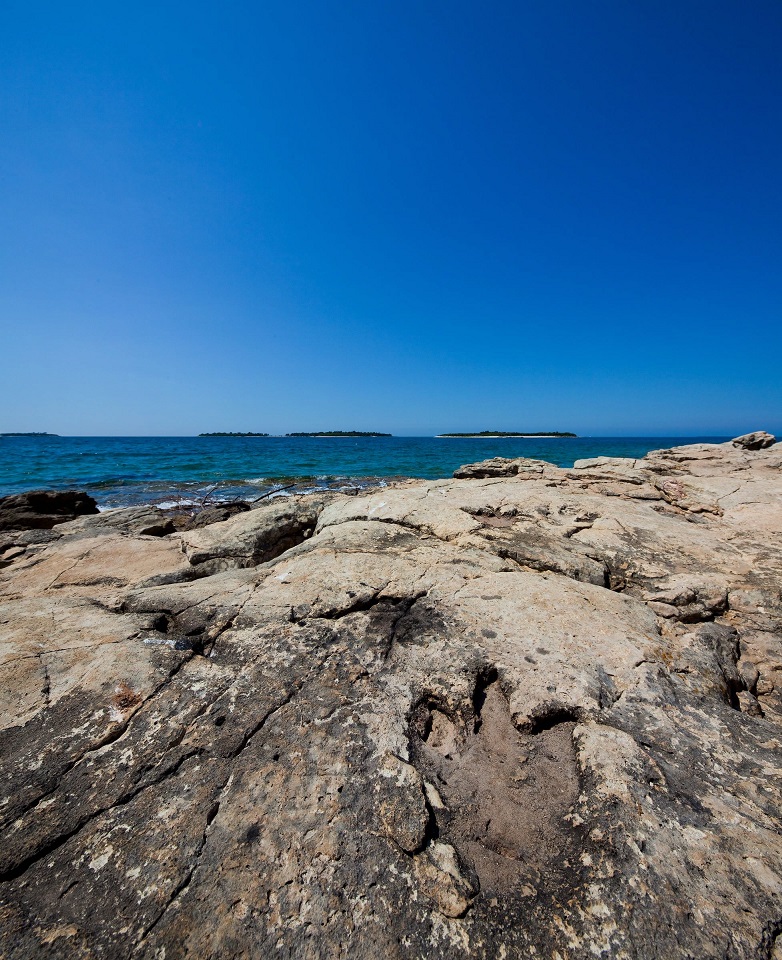
Dinosaur's fossilized feet on Brijuni, Istria / Copyright Romulić and Stojčić
Herbivores and carnivores
Paleontologists have registered more than 10,000 dinosaur remains worldwide: bones, skulls, teeth, coprolite (fossil feces), and fossilized feet. True, not a single coprolite was found in Istria, but according to the Istrian flora in Cretaceous, it is quite clear that herbivores have fed well with rich plants of that time: tall and lush ferns, flowering plants, coniferous and deciduous treetops.
Carnivores have fed on everything that moved. And altogether, they richly fertilized the soil of their habitat so that it would respond with an even richer "table".
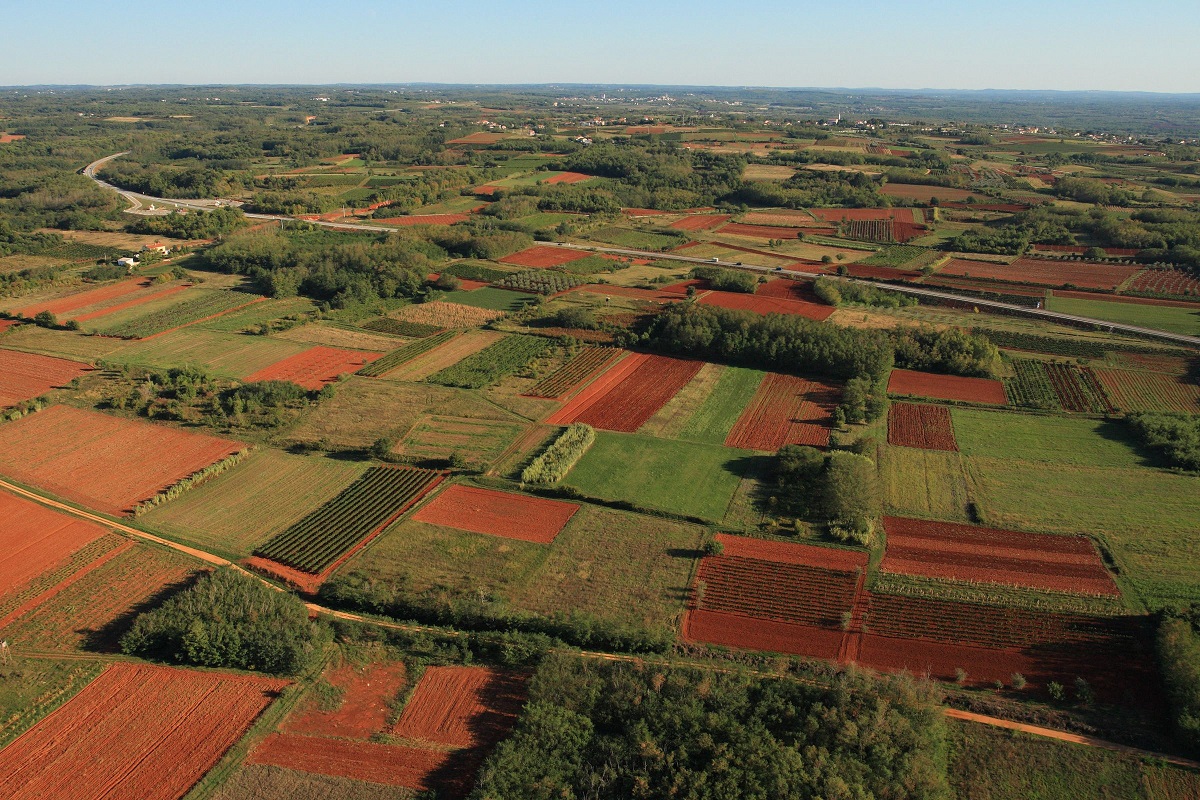
Istria / Copyright Romulić and Stojčić
Among Istrian dinosaurs, scientists mention herbivorous sauropods and carnivorous theropods. The herbivore brachiosaurus is especially impressive. It is 27 meters long and 12 meters high, and weighing about 70 tons.
Certainly, numerous dinosaurs with their huge bodies, appetite, and rich remains have ennobled this Istrian land over millions of years, be it red, black, gray, or white. Hardworking Istrians grow olives, vines, vegetables, fruits here today. They extract the best olive oil, the finest Malvasia, Merlot, Teran, Cabernet Sauvignon from the fruits of the earth.
The autochthonous Istrian Boškarin has been grazing here for two and a half thousand years, together with cows, sheep, and goats. Thousands of guests of this beautiful region enjoy it all today. But it must not be forgotten – in the beginning, there were dinosaurs here.
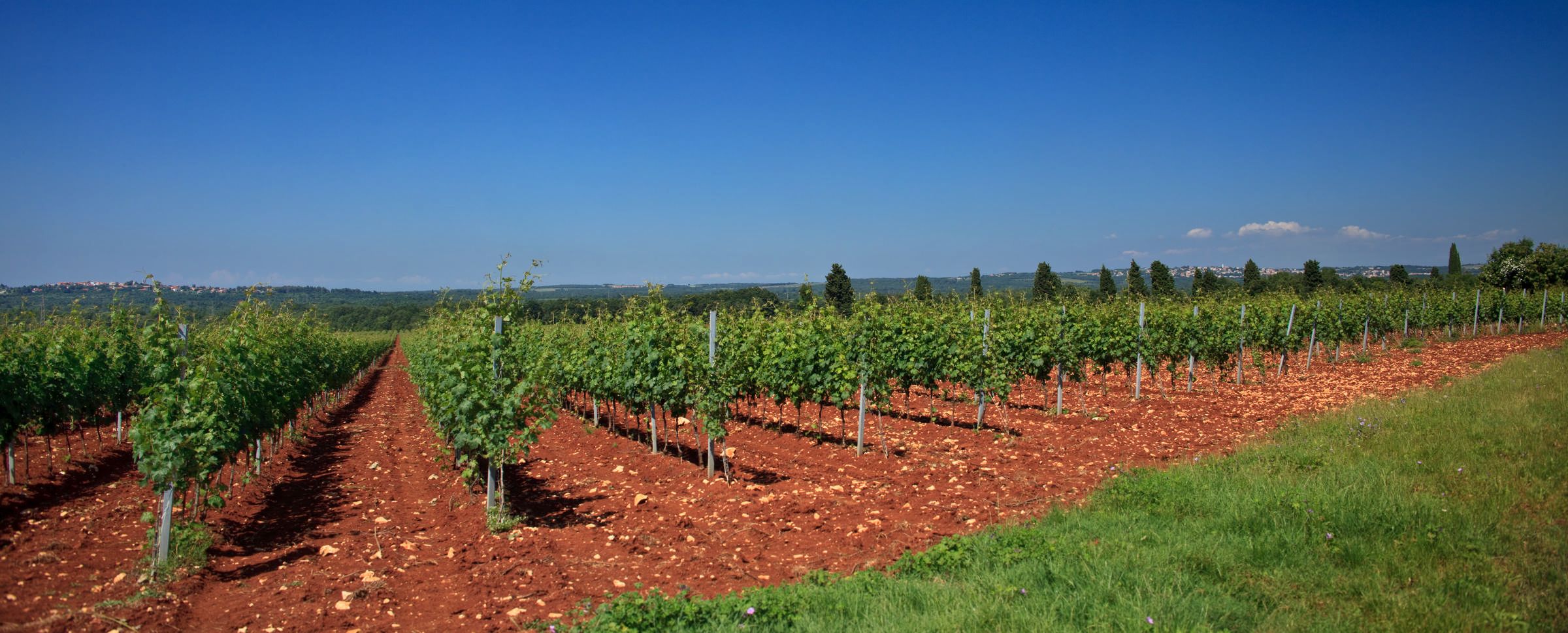
Vineyard in Istria / Copyright Romulić and Stojčić
So, let’s leave room for some unscientific, but simple conclusions. Can so much biomass go unnoticed? Aren't dinosaurs responsible for the exceptional Istrian wine terroir? For the top quality local olive oil?
Dinosaurs may have disappeared 65 million years ago, but before that, they lived, multiplied, and died here in Istria for a full 80 million years.
For the latest travel info, bookmark our main travel info article, which is updated daily.
Read the Croatian Travel Update in your language - now available in 24 languages
Around Istria with Environmentally Friendly Transport
August 29, 2020 - Istria is in the limelight as the Istrian Development Agency implements two cross-border cooperation projects with Italy. The main goal is to connect the coast and the interior as well as the promotion of environmentally friendly forms of transport.
In addition to other activities of the Istrian Development Agency and the experience of 50 implemented EU projects with a total value of HRK 500 million, two projects in the field of mobility are being implemented, in which IDA is a partner. As Lokalni.hr writes, these are ICARUS and MIMOSA.
ICARUS project
Last year, a project called ICARUS - Intermodal connections in the Adriatic-Ionian region foresaw the growth of seamless solutions for passengers and invested in that with a total value of 2,200,000 euros, of which 180,000 euros are intended for IDA.
In partnership with HŽ passenger transport, this project will arrange a section of the train on the Istrian railway for the needs of bicycle transport. Travellers will have the opportunity to continue their journey by exploring other parts of Istria after exiting at one of the stations on the route or the new bike path Kanfanar - Rovinj. This second option will be possible after the completion of the reconstruction of the former railway line, which is being regulated by the City of Rovinj and the Municipality of Kanfanar, and to which the Istrian Development Agency has partly contributed.
So far, the "Analysis of shortcomings and needs in mobility in Istria County" has been prepared within ICARUS. It is a study that includes a description of the current situation, the systems implemented so far, and the legal basis and relevant strategies, after which the "Guidelines for the development of IT solutions" were developed as a starting point for the following activities and projects.
As part of this project, IDA held a webinar in cooperation with the Istrian Development Tourist Agency on the topic of bicycle transport in Istria, attractions near bicycle paths and plans. After the webinar, a quiz called "Discover Istria by bike" was organised, the winner was awarded a bicycle, all with the aim of promoting healthy transport habits.
Three years to finish
As ICARUS has established good cooperation and communication with local and regional stakeholders, representatives of the public and private sectors, useful information has been obtained for further development. They are included in the activities of another project in which IDA is involved, and that is MIMOSA (Maritime and multimodal sustainable passenger transport solutions and services), with a total value of 7,140,000 euros, of which IDA has invested 374,750 euros. Implementation began in July this year.
In this project, the Istrian Development Agency will focus its activities on two pilot activities. The first one is the development of a smart card, and the second is the platform "Via Istra", which will enable the promotion of available forms of transport in Istria but also create new opportunities for economic development and supply in this region. The expected duration of the MIMOSA project is three years, and some of the partners are HŽ passenger transport, the Port of Rovinj Authority, and the Ministry of Regional Development and European Union Funds - Directorate for Islands.
For the latest travel info, bookmark our main travel info article, which is updated daily.
Read the Croatian Travel Update in your language - now available in 24 languages
More Than a Hundred Thousand Guests Left Istria From Noon on Friday Until Sunday
Pula, August 23, 2020 – A total of 53,592 passengers entered and 100,948 left, mostly foreign nationals, from three road border crossings in Istria – Plovanije, Kaštela, and Požana – from noon on Friday to Sunday, the police officer of the Istrian Police Suzana Sokač reported. She added the traffic at border crossings is intensified, but without major congestion and waiting.
As HINA writes, according to information from the border police, more than 38,000 passengers left Istria through these border crossings on Friday alone, and Saturday almost 43,000 guests. Such a scenario was expected so on Friday the tourists from the UK massively left Istria due to the decision of the British Government that self-isolation is mandatory for all those returning from Croatia.
During the whole weekend, the traffic at the border crossings was heavy in both directions, so in Plovanija and Kaštela was a wait of about one hour yesterday, the Istrian police reports. The traffic in Istria was unhindered, without major delays.
For the latest travel info, bookmark our main travel info article, which is updated daily.
Read the Croatian Travel Update in your language - now available in 24 languages
PHOTOS: Spectacular 45th Prstenac In Barban, Istria
August 22, 2020 – After a 280-year absence, the historic Prstenac in Barban jousting tournament once again brings thrills and visitors to inland Istria.
Following a 280-year absence, the weekend of the historic Trka na Prstenac in barban jousting tournament has begun once more. Since it was revived, this is the 45th consecutive time the colourful event has drawn spectators and competitors to the village of Barban. The first recorded mention of Trka na Prstenac in Barban comes from the year 1696.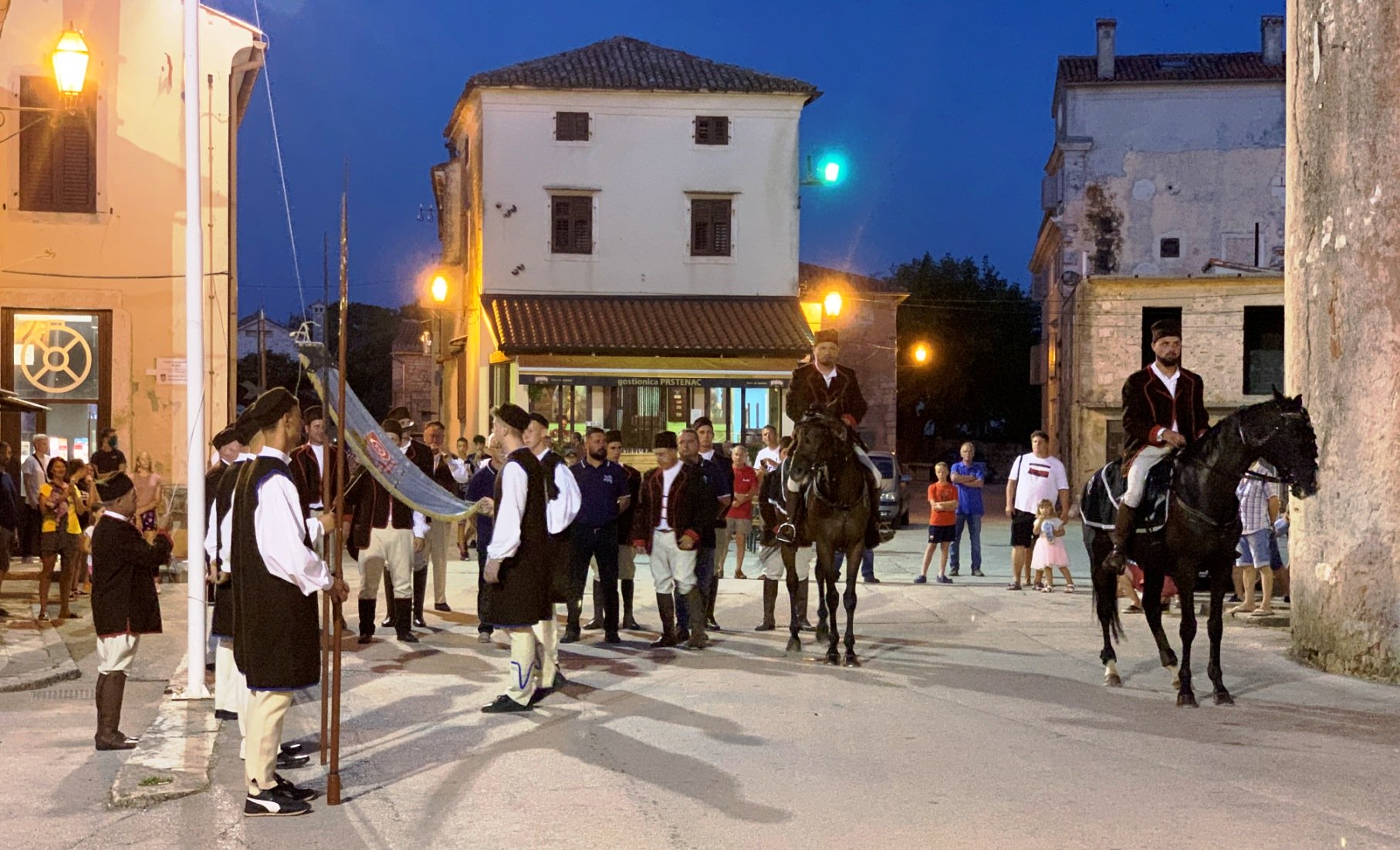
Flag raising on the opening night
The weekend-long festivities started on the evening of Friday 21 August with the traditional raising of the event flag in the square by the Parish Church of St. Nikola. Horsemen in traditional costume entered through the stone gate and performed the ancient ceremony before visitors gathered under recently darkened skies. The names of this year's competitors were read aloud. Following the theatre, visitors enjoyed the premiere screening of a documentary '30 Seconds', which followed four of the event's previous competitors.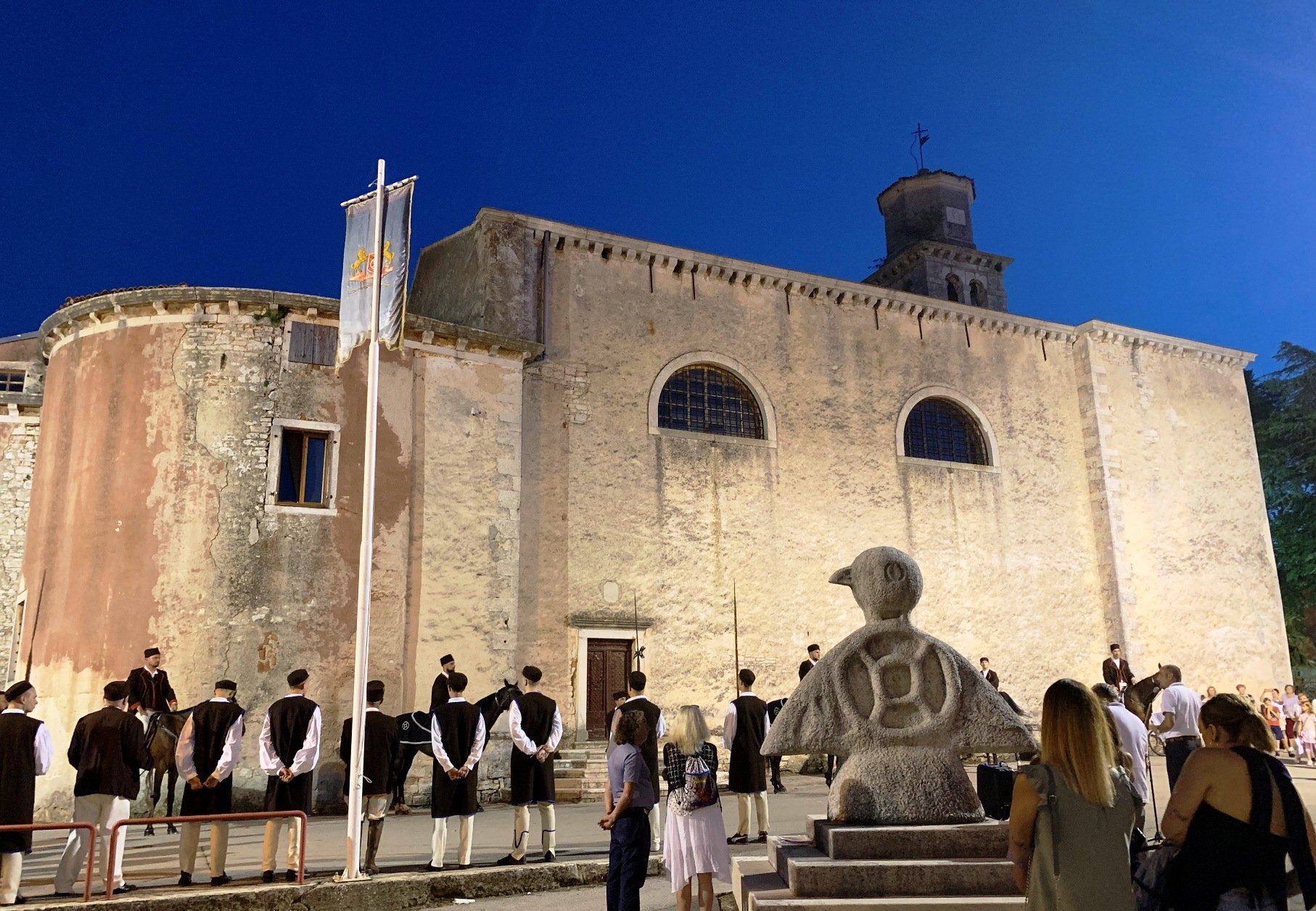
Traditional Istrian folk costumes were worn, adding a timeless aspect to the theatre of Friday night at Prstenac in Barban
During the competition, horsemen must charge at full gallop down the 150-metre-long Gradišće trail and hit a suspended ring with a spear. Their endeavours require incredible skill and accuracy. Occurring at such high speeds, each individual run takes less than 12 seconds. The riders have practised this many times before coming here and have undertaken trial runs in the village since Wednesday.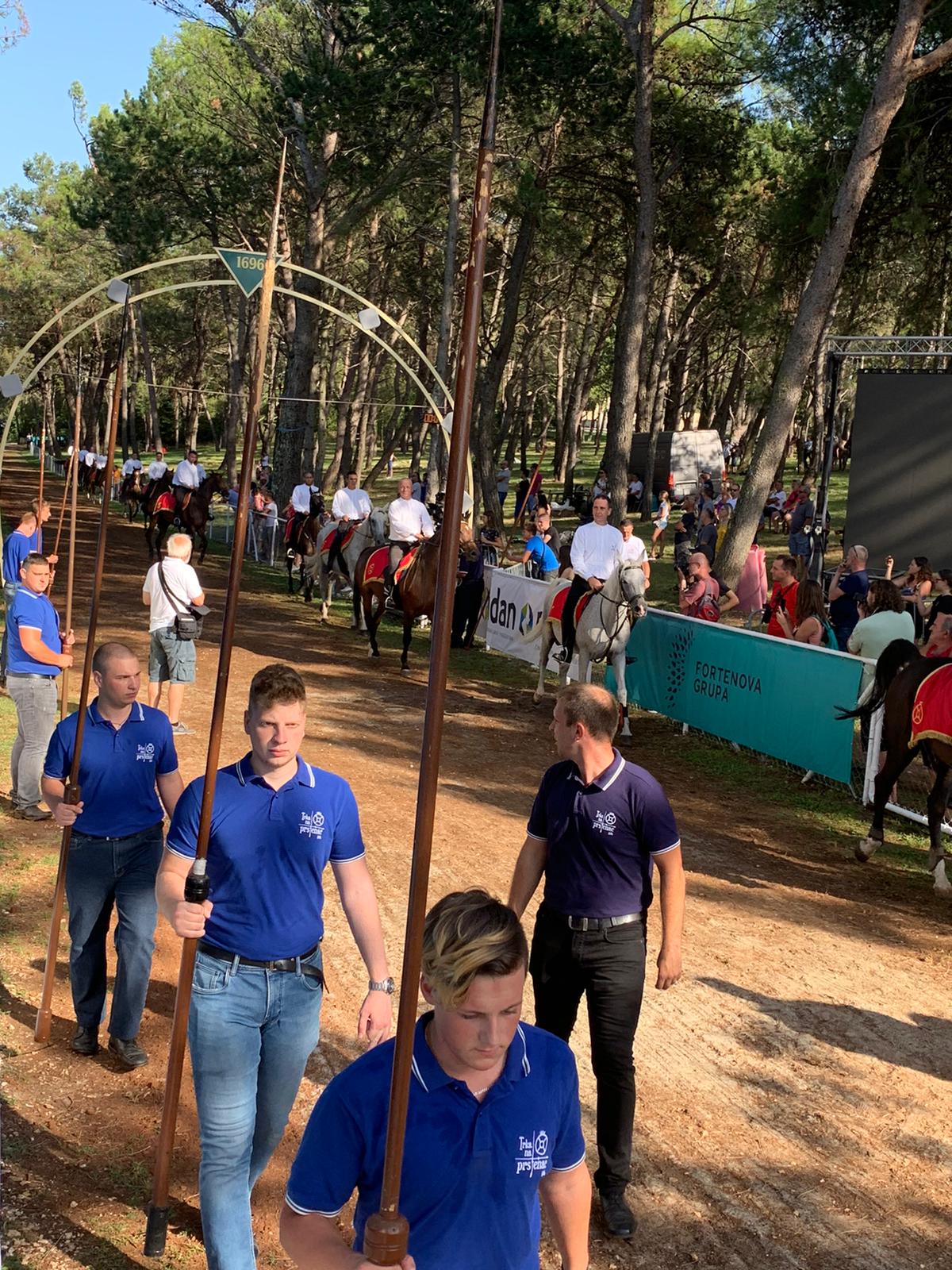
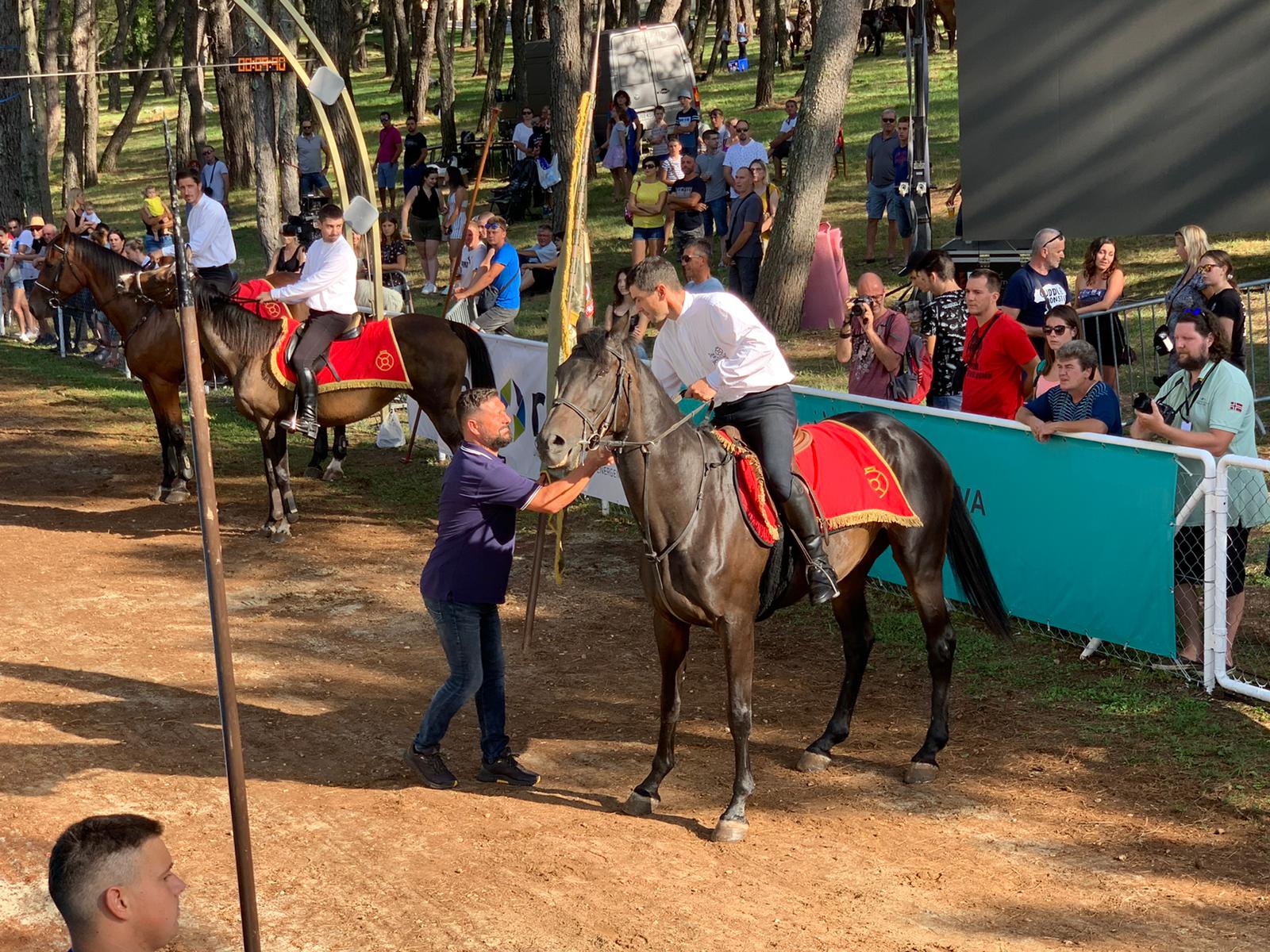
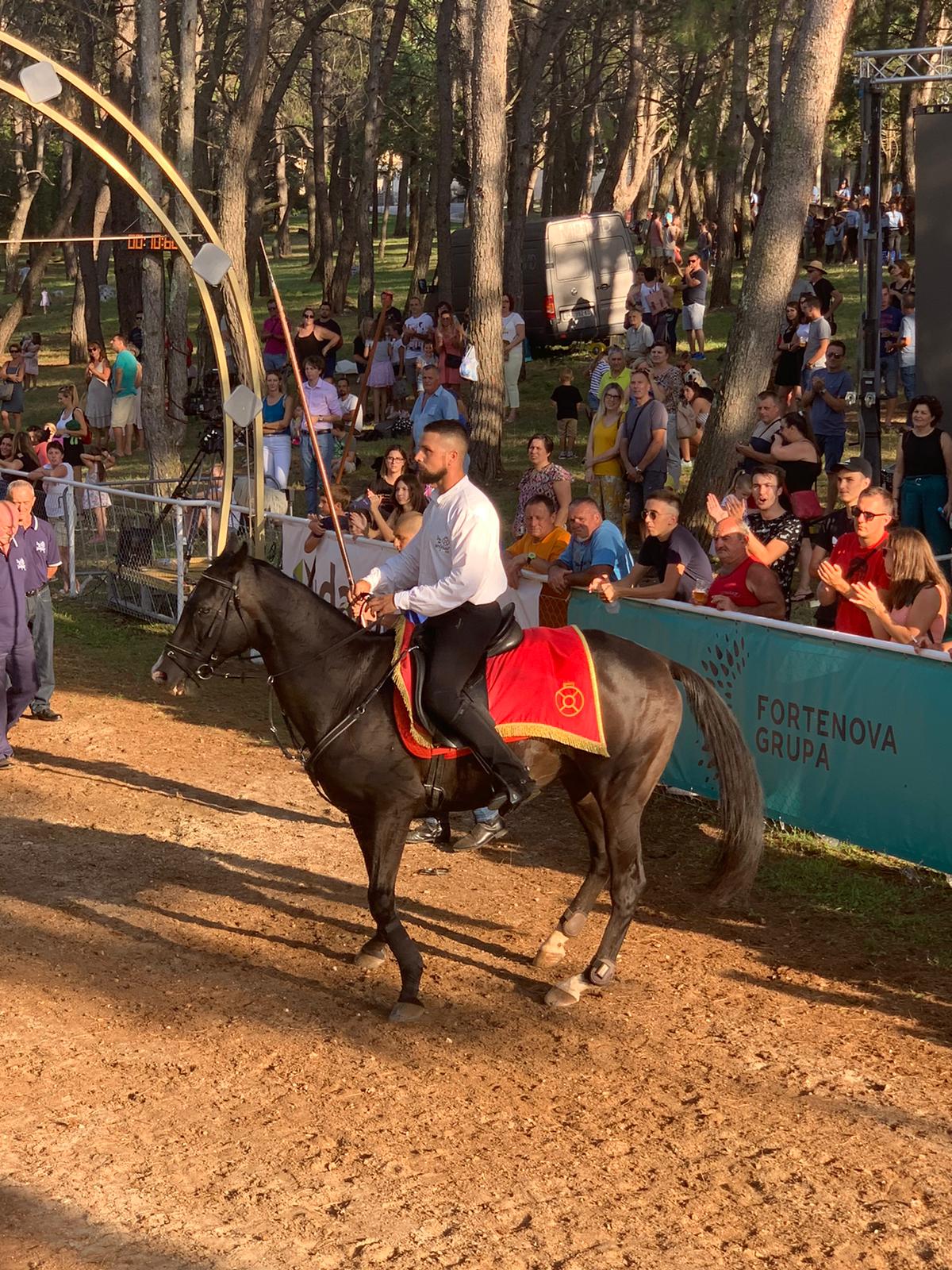
Three images from the build-up to Saturday's Vine Race (Trka za viticu)
The Prstenac in Barban has taken place on the penultimate weekend in August every year since 1976. The thunderous sounds of horse hooves could not be silenced by COVID-19, although this year attendee numbers have been limited to 1,500.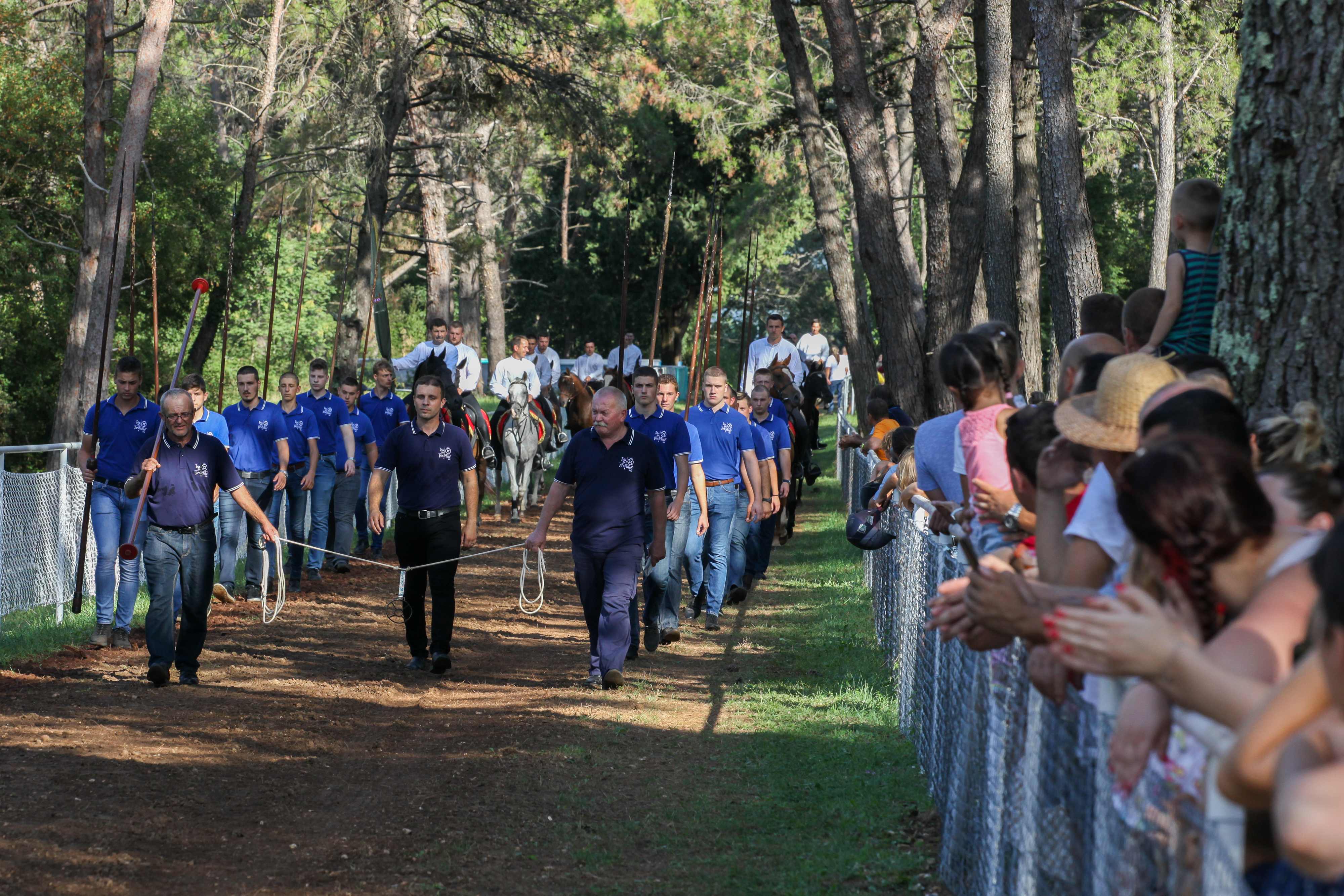
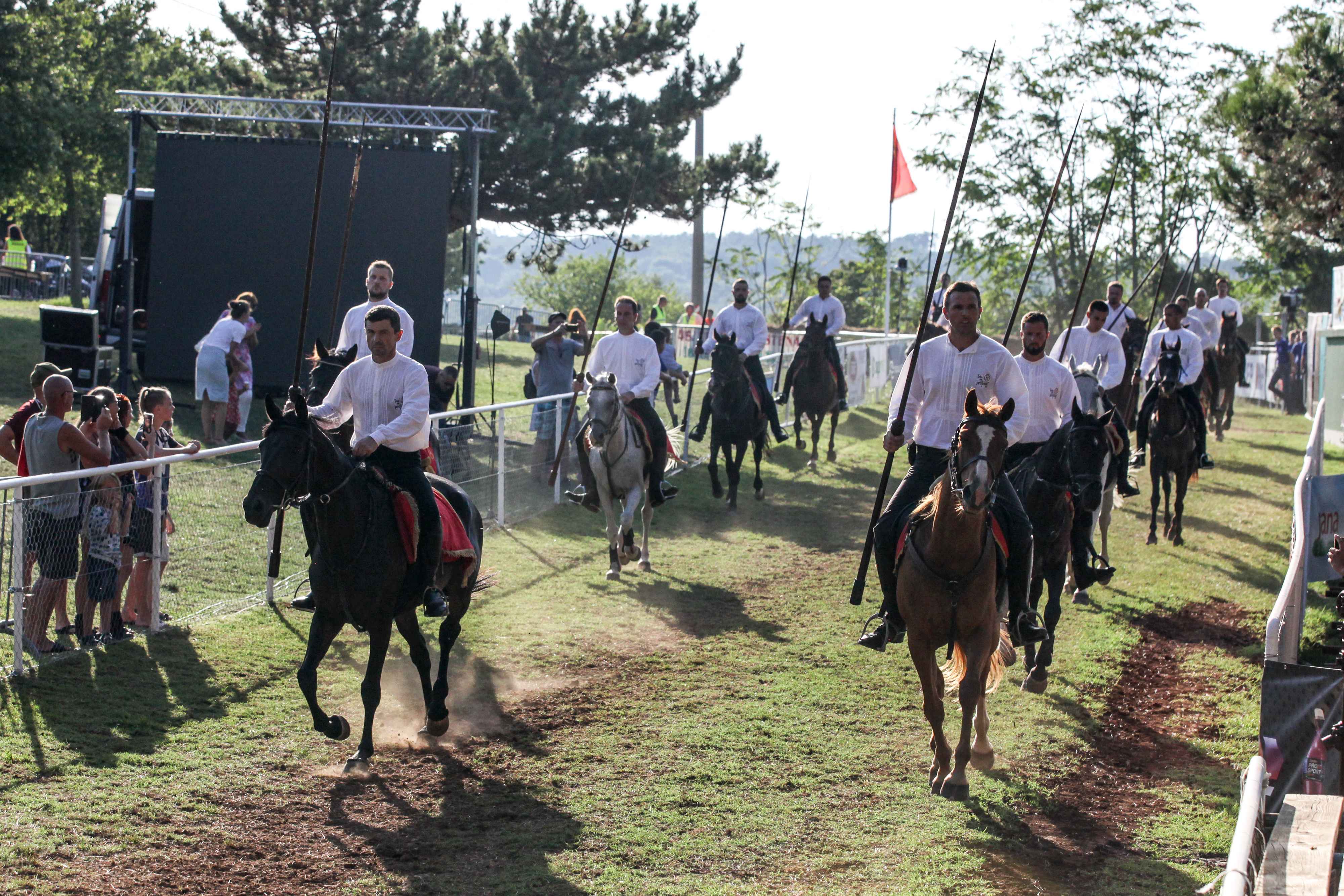
16 horsemen are entering this year's event in the hopes of winning the traditional prize of a dagger and a shield. An additional prize, "The Bird Ring", the work of sculptor Josip Diminić, will also be awarded. The competitions began just after 5pm on Saturday 22 August with the Vine Race (Trka za viticu). This was the 25th annual undertaking of this pre-event. Later in the evening, clay pigeon shooting would take place under the challenging conditions of nightening skies.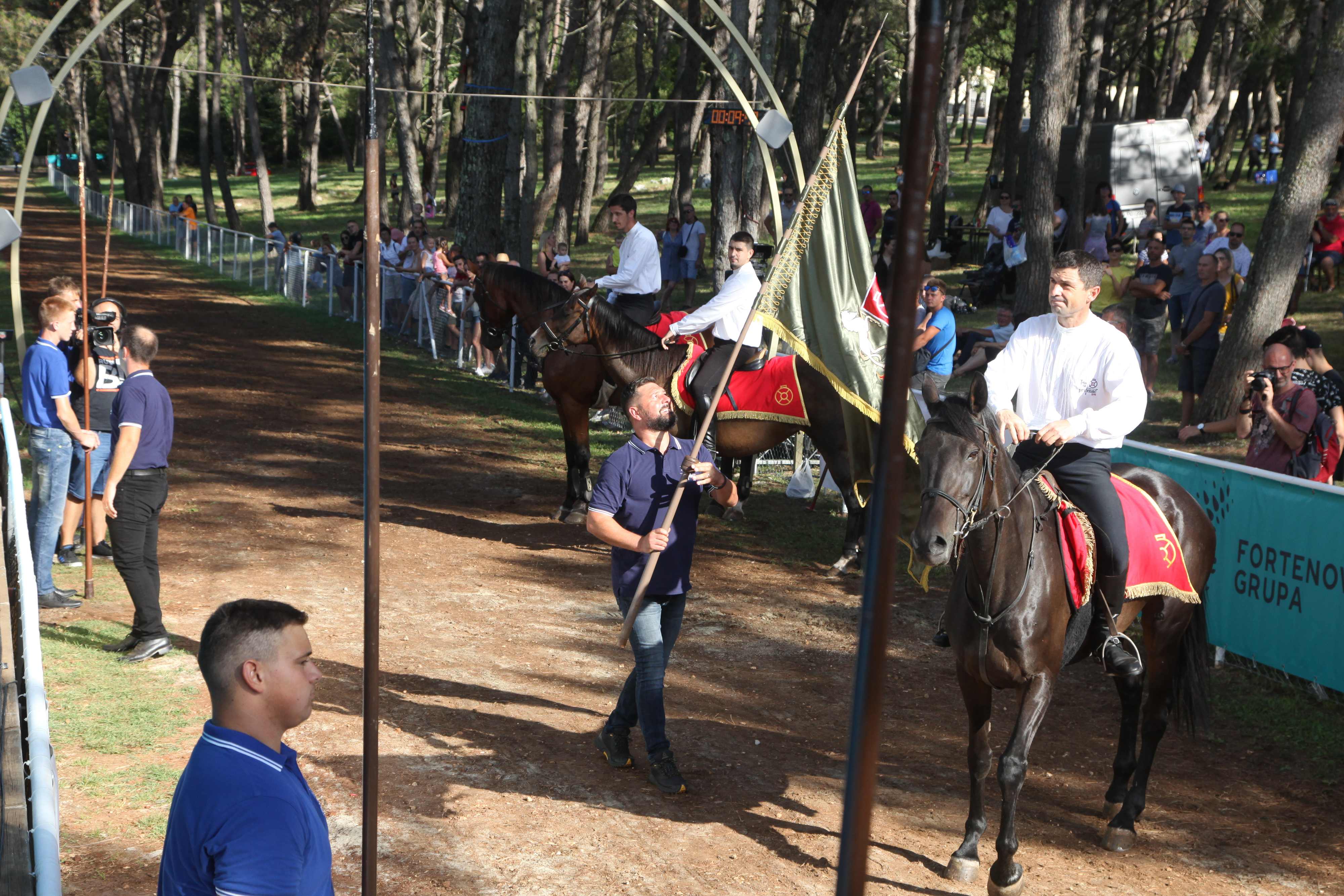
The winner of Saturday's Vine Race was Milio Grabrović. He rode a horse called Ulika and was assisted by pikeman Aldo Paus.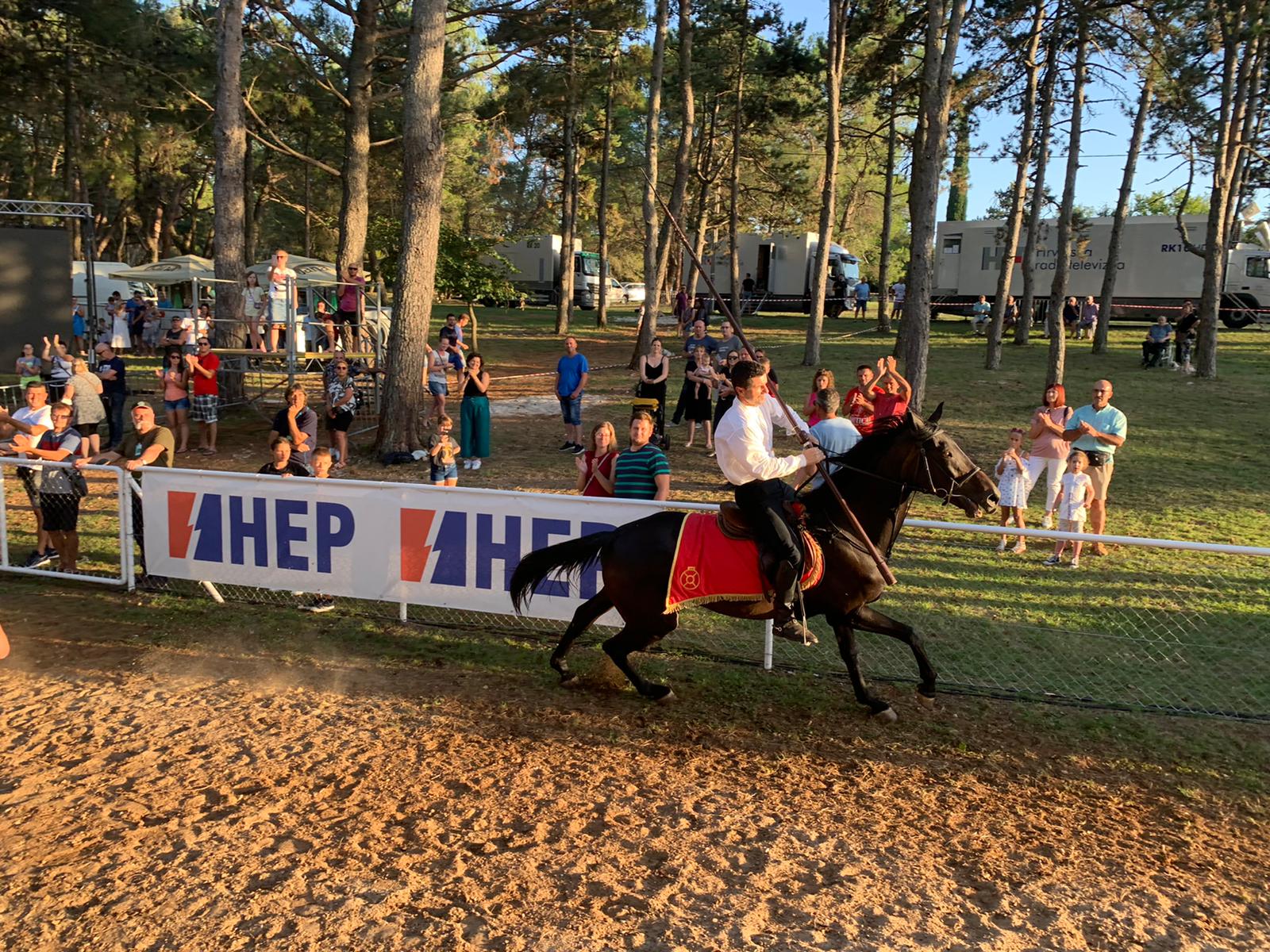
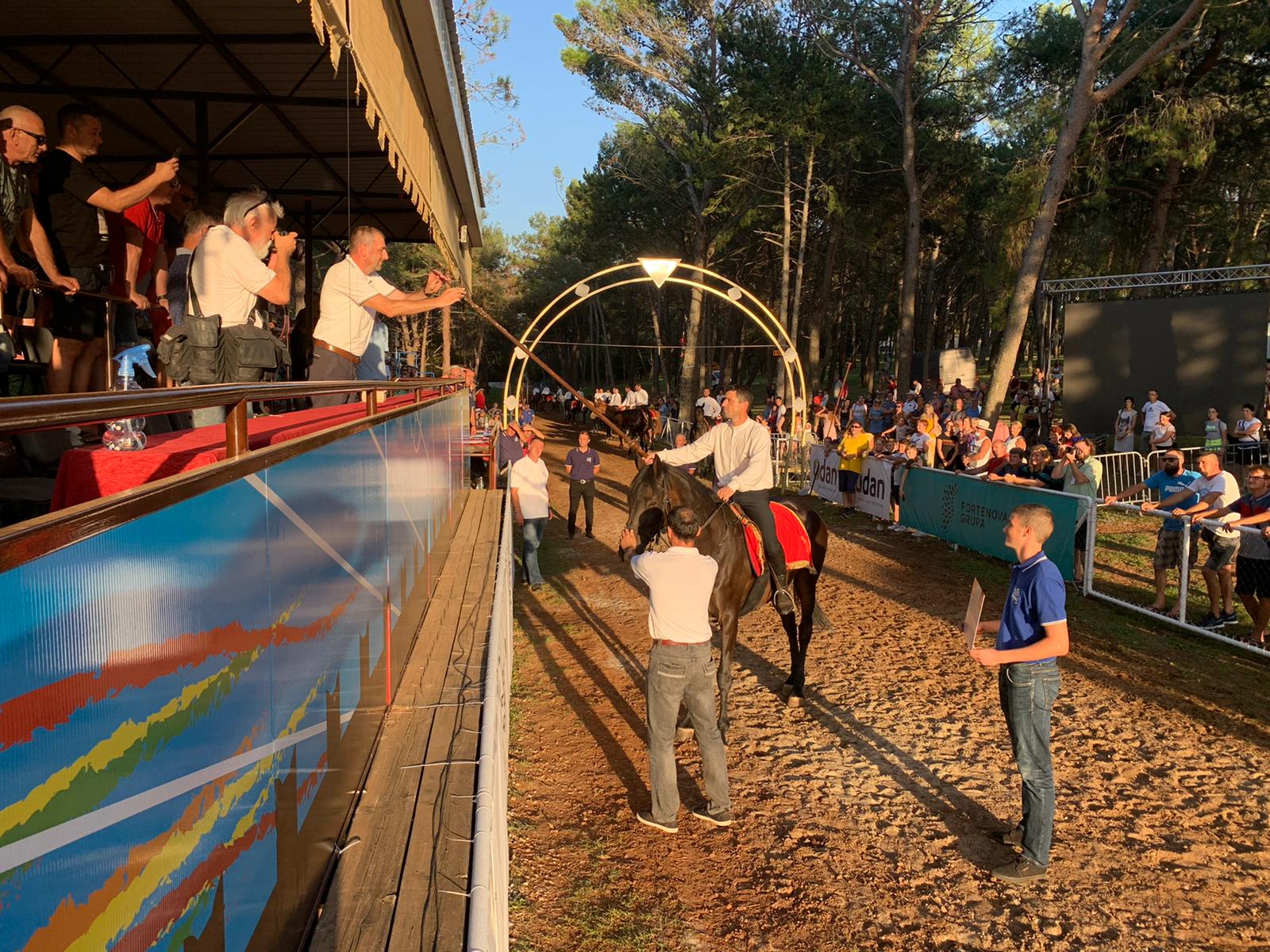
The main event, the Ring Race Trka na prstenac in Barban, will take place at the same time on Sunday 23 August. Those unable to attend this year will be able to watch the event from a live broadcast on TV channel HRT 2 from 5.15pm.
All photos © Trka na Prstenac in Barban / Goran Šebelić / Karmen Radetikio
Meet HGSS The Croatian Mountain Rescue Service
August 19, 2020 – All weather, all terrain, all year round – meet HGSS The Croatian Mountain Rescue Service, amazing volunteers who will never let you down
They're never far from the news. For the last two weeks, members of HGSS The Croatian Mountain Rescue Service have yet again been on the TV news every night. They're leading the search for a summertime visitor, a Polish hiker missing on Biokovo mountain.
But, watch again this winter and, for sure, they'll be in the headlines once more. Whether, they're scaling mountain ranges in the unbearable heat of high summer, searching underwater caves, flooded rivers or the sea, breaking through wild forest or trudging through metres of snow, they undertake their search and rescue missions over every terrain, in every weather condition, in every month of the year, all across Croatia. And, they all volunteers.
Marc Rowlands meets the head of service for HGSS The Croatian Mountain Rescue Service and three of its volunteers to find out who they are and what makes them do what they do.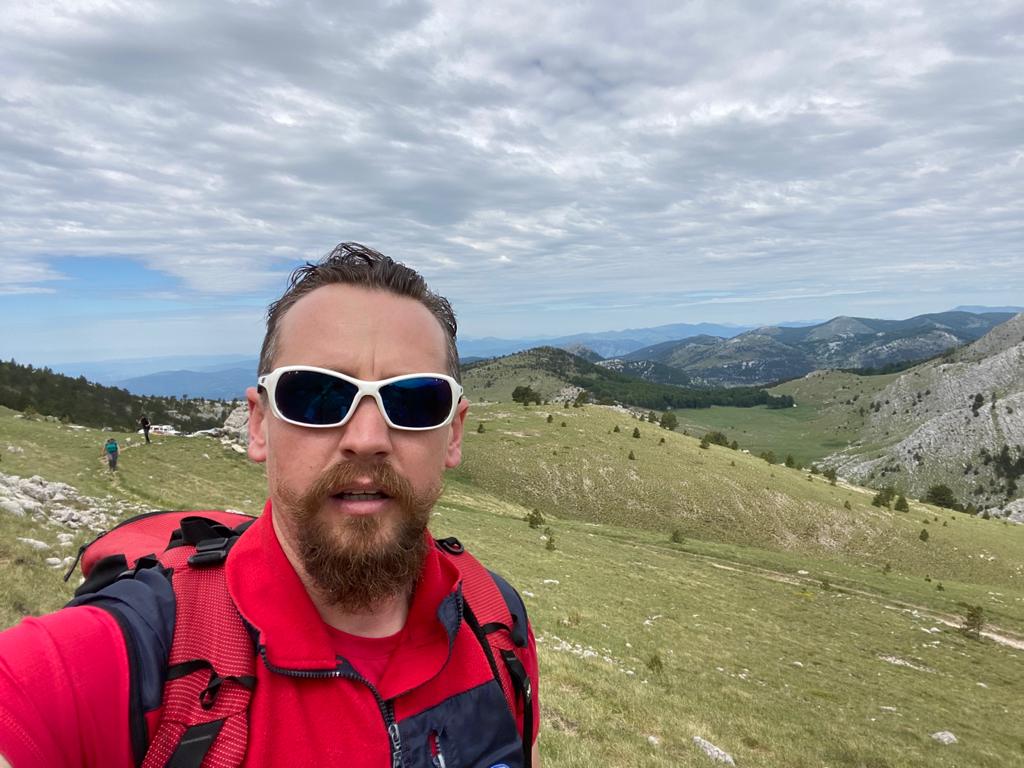
Josip Granić, head of service for HGSS The Croatian Mountain Rescue Service
My name is Josip Granić. I'm the Head Of Service for HGSS The Croatian Mountain Rescue Service. We've had an extremely busy couple of weeks. Being head of service for an organisation like this under such circumstances means you're always on the phone; co-ordinating, talking to outside organisations, members of the press. Communication. It's a 24/7 job, 365 days a year. If people need help, you can't take a holiday. Not at this level of the organisation.
We have around 1000 members. There are 11 paid positions in the main organisation and 25 people we pay to run the administration in each of the teams or stations we have. All of the members who perform the search and rescue are volunteers. We have pilots, surgeons, nurses, students, professors, every part of society.
I'm originally from Kaštela, but my home station is in Karlovac. I've been there for 15 years. I've been Head Of Service for two. Since I assumed the position, I've spent most of my time in the car. I travel all over Croatia.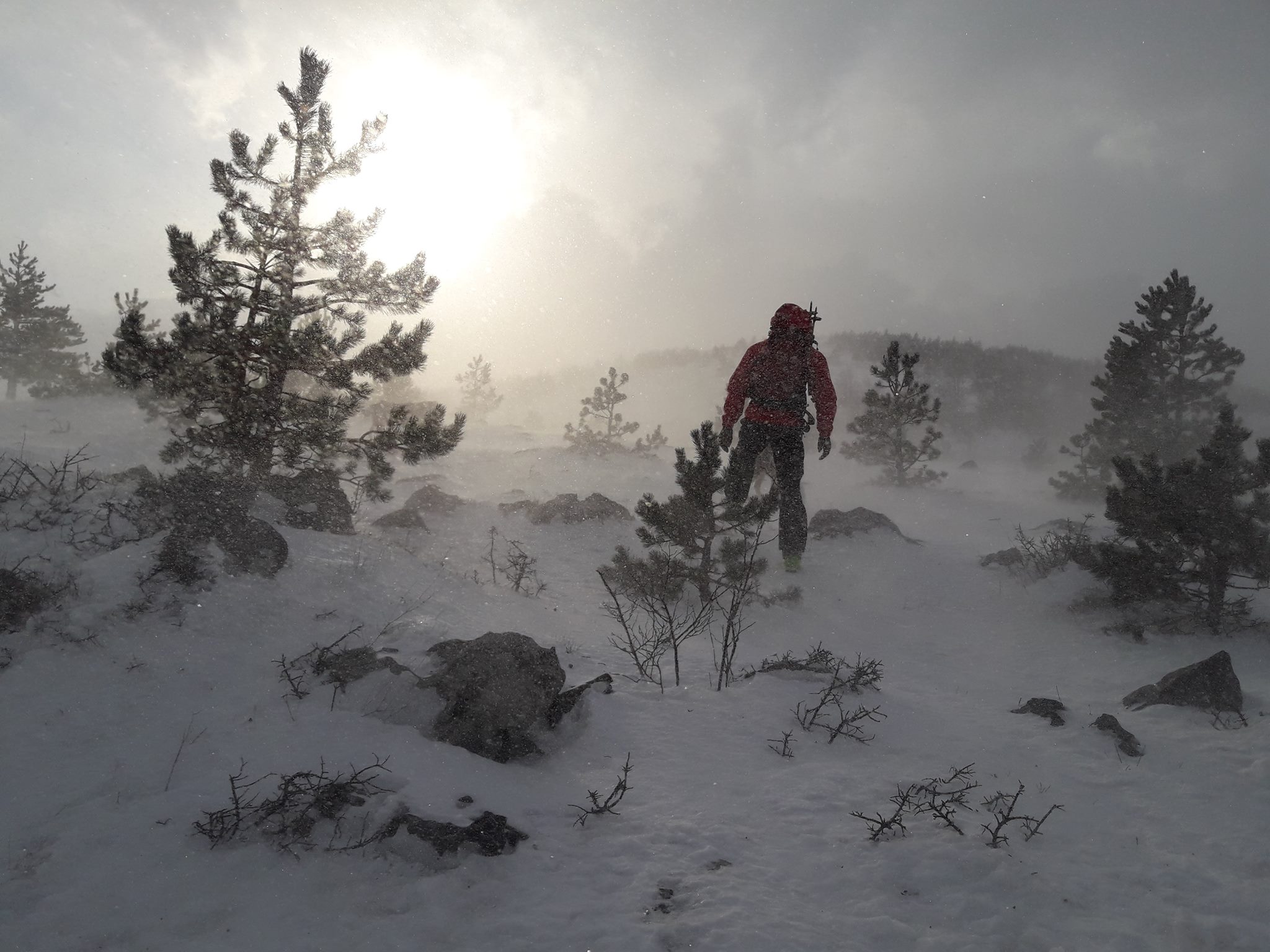
HGSS The Croatian Mountain Rescue Service missions can be hampered by extreme weather conditions © HGSS The Croatian Mountain Rescue Service
To get a certified position as a mountain rescuer in Croatia you all do the same training. It doesn't matter if you come from Slavonia, Dalmatia or Istria, you must have the knowledge and ability to deal with circumstances in any terrain; caves, pits, mountains, on snow, underwater.
Depending on where your station is, the type of call-outs you get could be very different. In Slavonia, 90% are for missing persons - searching forests, rivers, and in floods. We've had a big search on Biokovo mountain for the past 16 days. The stations from Split, Makarska, and Dubrovnik were at first involved, then teams from all over Croatia. It's not the same as Slavonia. The terrain is very different, so you have to be good at a particular set of skills. But, the largest percentage of call-outs is still missing persons. It's 70% of our work nationwide. The other 30% are rescues.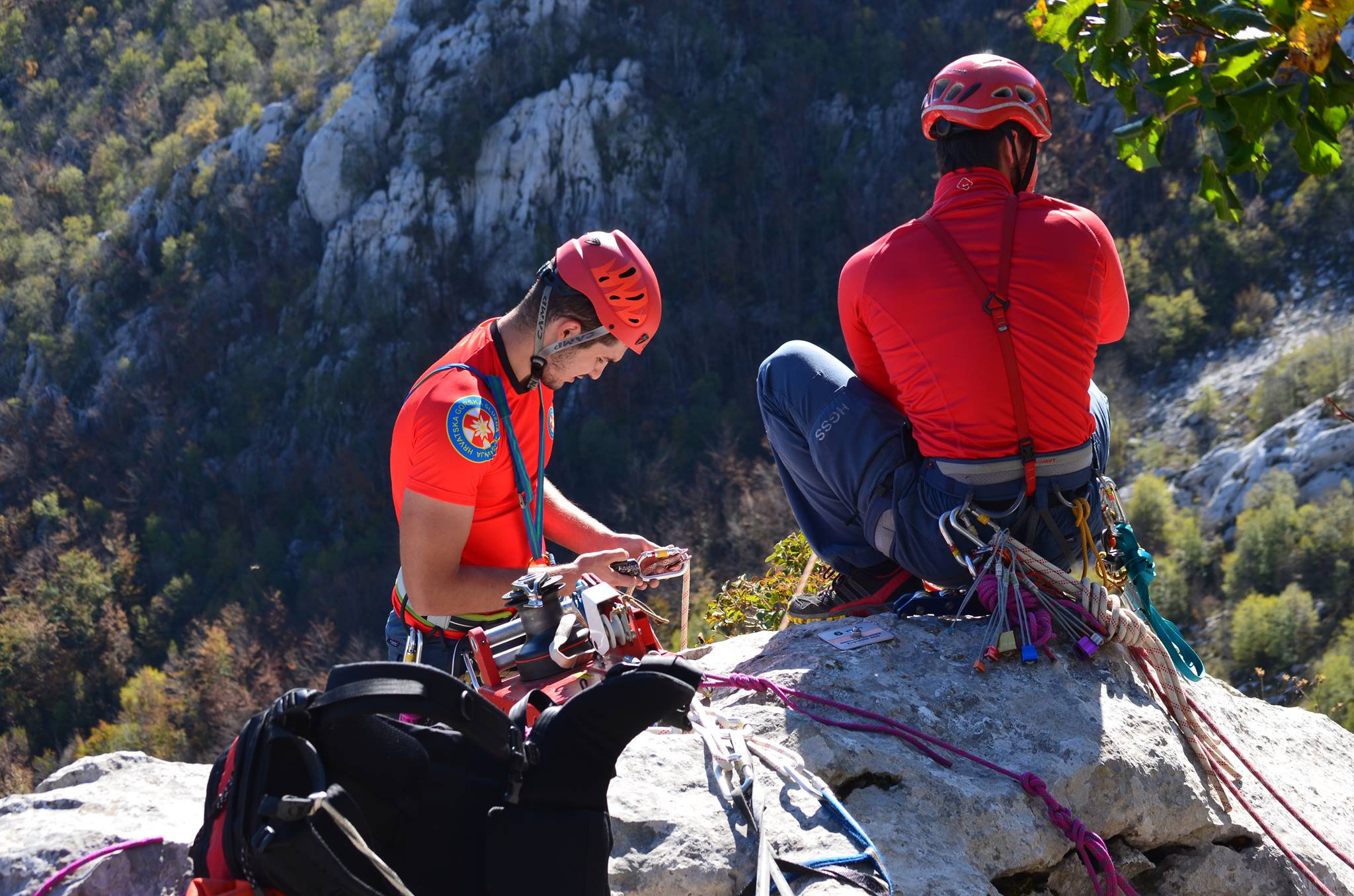
HGSS volunteers are educated to use a wide range of technical equipment. They are trained to operate in all the different kinds of terrain found across Croatia © HGSS The Croatian Mountain Rescue Service
There are usually 800 – 1000 missions a year across the country. We get roughly the same amount of calls in colder months as in warmer months. Only, winter months can be busier. The terrain is more difficult. There are some villages in Croatia – usually where the front line of the fighting was, around Karlovac, Kordun, Lika – and when it snows, it can be almost impossible to reach those places. But, some older people still live there. It can take days to reach them on snowmobiles, then skis, to deliver food or medecine. The other busiest places in winter are the ski resorts - Platak, behind Rijeka, and in Zagreb, on Sljeme. There are teams stationed in those places throughout the snow season.
What's the greatest danger of the job? Almost everything. Nothing in this job is easy. The greatest dangers we face are the same facing those that we rescue - underestimating the environment, nature, the conditions. That's where our training comes in.
In mountain rescue, we separate dangers into subjective, objective and technical. Subjective is the stuff you're guilty of - lack of preparedness, knowledge or equipment. Objective dangers are the ones you can't control, like sudden changes in weather, or avalanche. If you're sensible and informed, there should be no objective danger.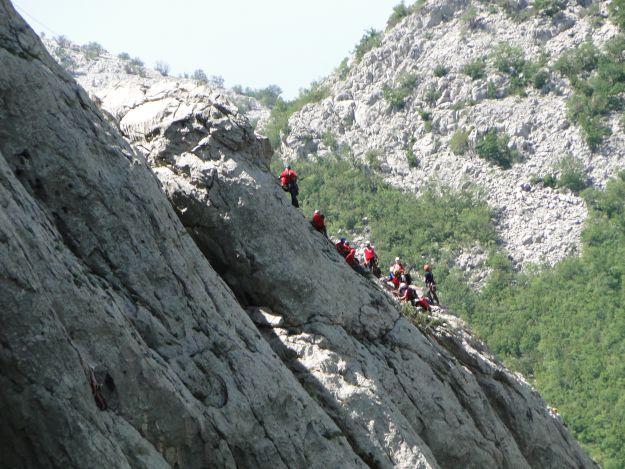
HGSS on a mission, clinging to a steep incline in Paklenica © HGSS The Croatian Mountain Rescue Service "People need to be aware at all times on the mountains. By the time most people think they may be in trouble, they've usually been in trouble for five or ten minutes already" Josip Granić.
80 – 85% of the people we rescue are Croatian. Only 15 – 20% are guests. People from Czech Republic, Slovakia, Poland, (Austria and Slovenia too) tend to enjoy nature more. They like hiking. That's the reason there are typically more rescues for those nationalities than there are for British, Belgian, French, Italian, America, Canadian or Australian guests. I don't remember the specific year, but sometime between 15 and 20 years ago we had a season where 5 or 6 Czech nationals were being searched for or, sadly, turned up dead. The media covered it and ever since there's been this myth that all the people who get into difficulty are Czech.
The question about expensive helicopter rides - why don't you charge the people you rescue - has been here forever. It's like this - if you're a tourist and you have a car accident in Croatia, the fire service, police and an ambulance will come. You won't get charged. We are a tourist country. According to international agreements, we are obliged to make everything safe for residents and guests alike. We are here, just like the fire service and police, to do our part. The Croatian air force is responsible for the helicopter rides and I have to give credit to them - they are crazy good pilots. Amazing. Even if we did charge everyone we saved - and most of the 85% of Croatians we save would struggle to pay - it still wouldn't be anywhere near the money required to run this service.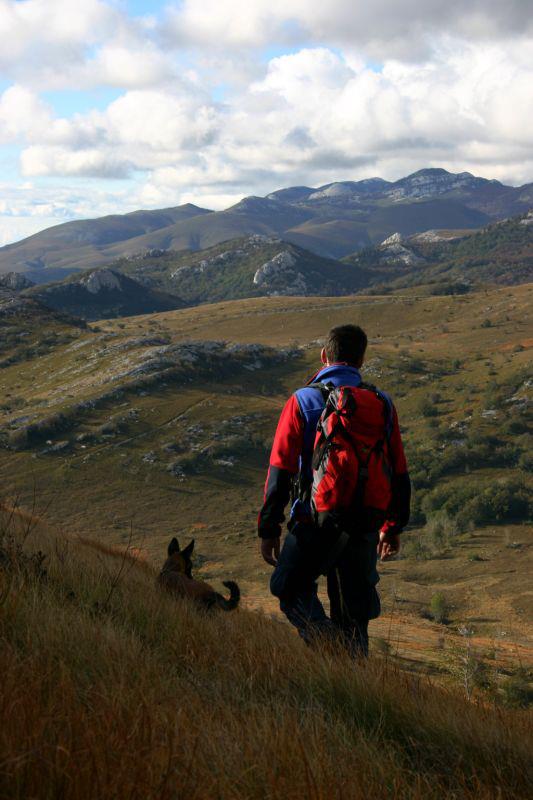
The Croatian Mountain Rescue Service used specially trained dogs on their searches © HGSS The Croatian Mountain Rescue Service
In 2007, I got a new search dog. It came from the Ogwen Valley Mountain Rescue service in North Wales. We cooperate a lot. We were sent out on a job to look for a three-year-old male child who had gone missing near Požega at the beginning of January, wintertime. His grandma was watching him and they were in a house on the edge of the woods. Early in the morning, he was playing with a dog. It suddenly ran into the forest and the boy chased after him. The grandmother didn't see it happen. I found him using my new dog, just after 8 o'clock the next morning. He'd been alone in the freezing forest for almost 20 hours.
Time is really moving fast on a job like that, because it's a kid and because it's so cold. Survival rates in such conditions are not good after 24 hours. When I found him, saw that he was alive, those big eyes looking up at me, it's a crazy feeling. You can't describe it. You can't compare it. A lot of positive emotions.
Every mission is special. We meet them all with the same level of determination and professionalism. But, it's the ones where you know you've really saved someone that stand out in the memory. Not the broken leg, where you transported someone – sure, that's an excellent job. But, when you know you've saved someone's life, that they definitely wouldn't be here now if it weren't for you, that's what makes it all worthwhile.
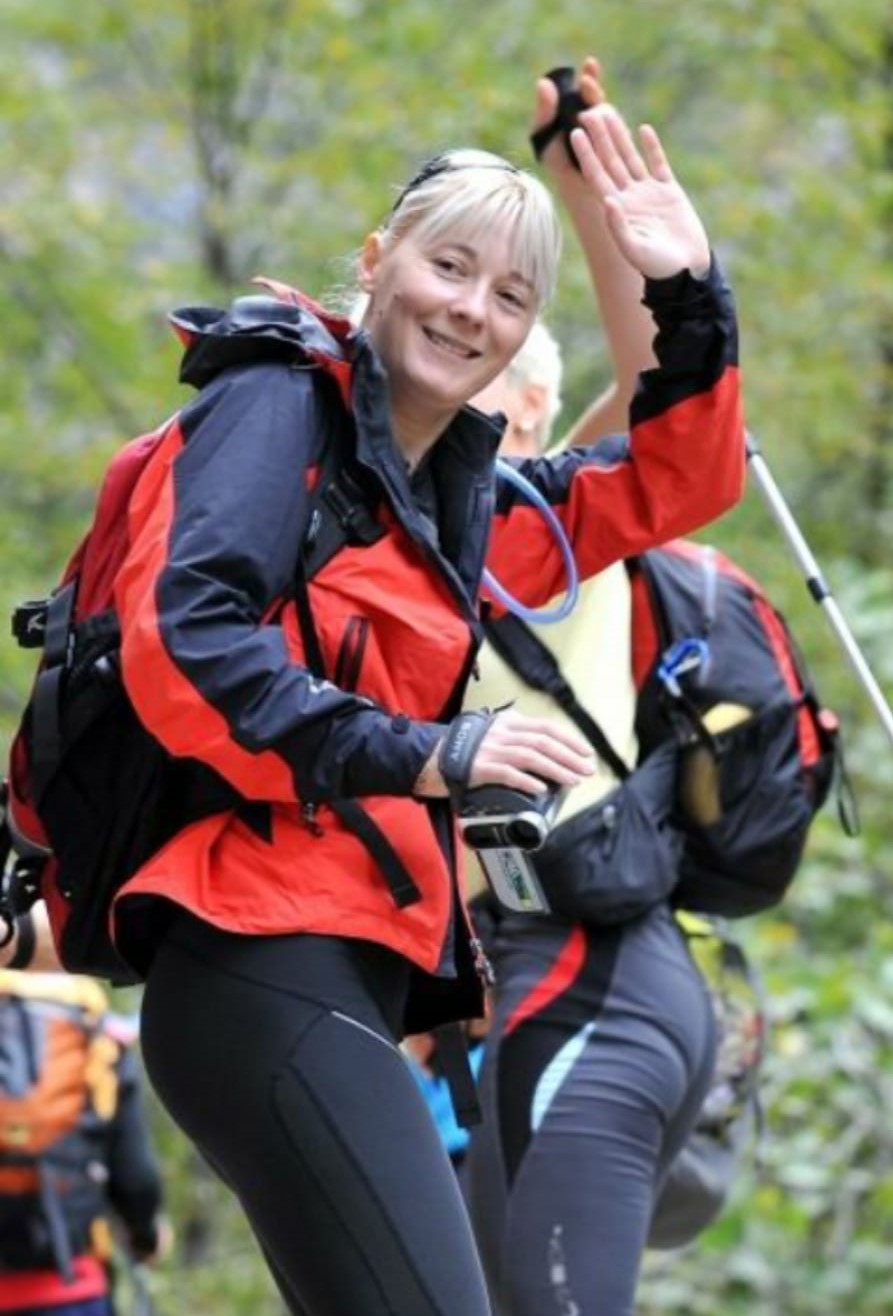
Jana Mijailović, volunteer for HGSS The Croatian Mountain Rescue Service
My name is Jana Mijailović, I'm 48 years old and I'm from Zadar. I finished school to be a teacher, but I never did it. My husband and I run a company that does plastic and aluminium windows for houses.
I started to go into the mountains when I was at high school. I never had the ambition to be part of mountain rescue services – people just noticed me on the mountains. They said I'd be good at it and asked me to join. I met my husband on the mountains. We are both volunteers for HGSS The Croatian Mountain Rescue Service. I've been doing it for 16 years.
I was a member of the first and second all-female Croatian expeditions to the Himalayas. We first climbed Cho Oyu in 2007, then Mount Everest in 2009. Croatia is the only country in the world that has only one successful male climber of Mount Everest, but four successful female climbers. I sometimes work as a guide too. I guess you could say I'm all about the mountains.
Being a climber, an Alpinist, I know that if I get into trouble, it's only my HGSS colleagues who can help. I feel this instinctively. I cannot be in the house, safe and warm, knowing that maybe someone needs help that only I can provide.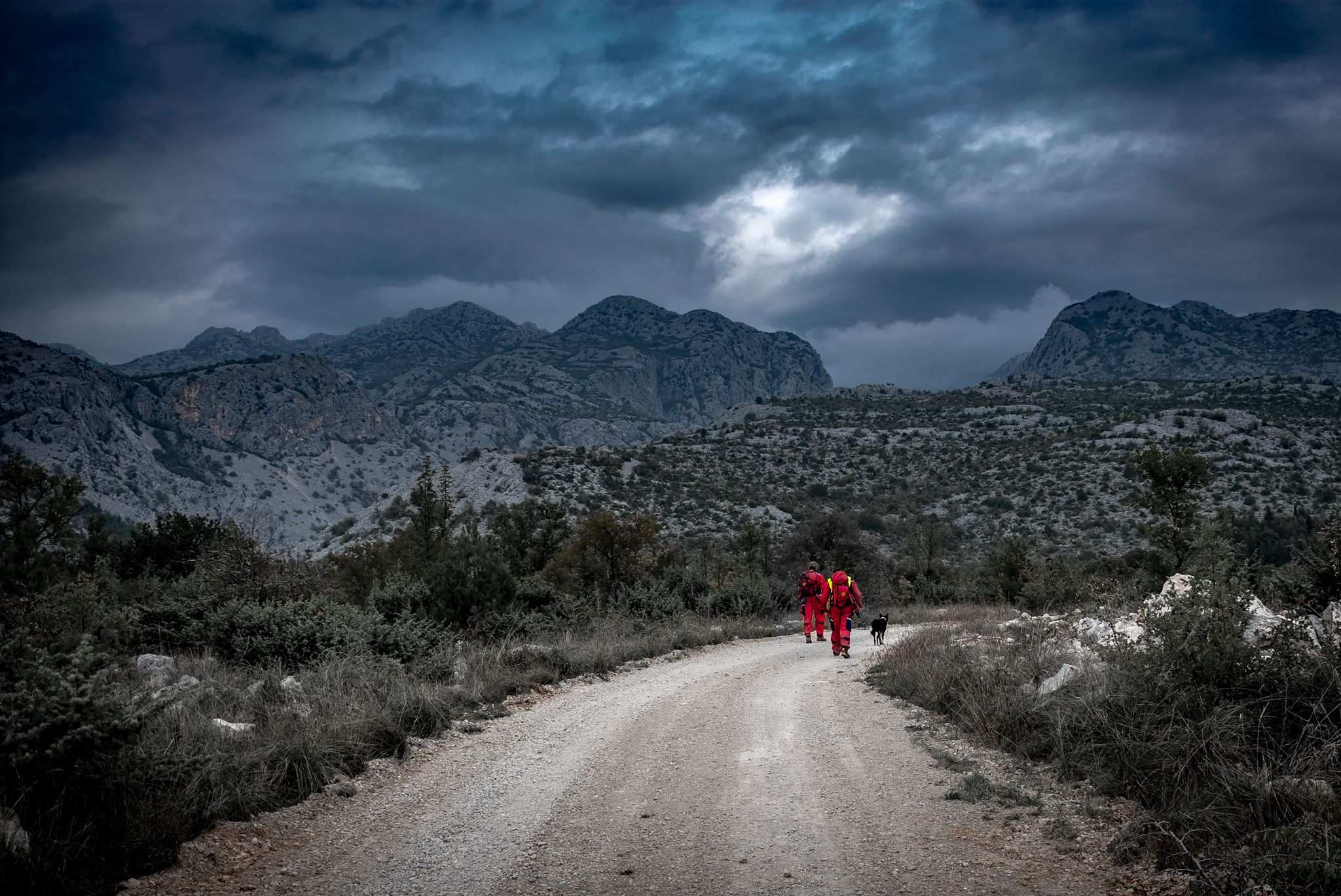
HGSS The Croatian Mountain Rescue Service members entering Paklenica under foreboding skies © HGSS The Croatian Mountain Rescue Service
I've really been on so many expeditions with HGSS. My station are on duty in the season at National Park Paklenica and I'm now the coordinator. Climbers from all around the world come and so there are many interventions. None of them are easy because the terrain is incredibly difficult. You really have to be in shape and know the techniques inside out.
I'm very proud of my statistics. Everyone I've rescued, who was alive when I reached them, is still living today. Unfortunately, not everyone we reach is alive when we arrive.
I remember one time, my husband and I were having dinner. We were arguing about the techniques and knots for moving a stretcher down a vertical climb. The training is so intense, you really have to know it well, and I guess that's just the kind of people that we are, that we would be arguing about it in our free time. Ha! He told me, "Why do you care? You'll never have to do that," because usually, it's really strong guys who do that specific job. If you're on a 400-metre-high section of rock, it really takes a lot of muscle.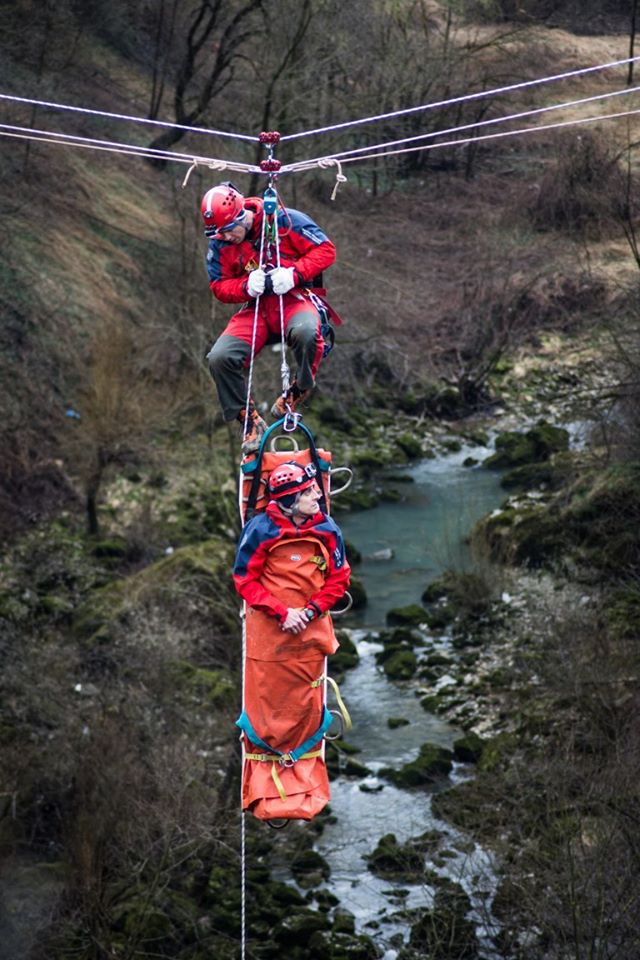
Ascending from a valley floor or descending from a mountain peak with a stretcher is a technically difficult operation, often hindered by darkness and adverse weather conditions. It requires a lot of training and a lot of muscle © HGSS The Croatian Mountain Rescue Service
In the evening, just two days later, we were called out to rescue an Italian guy who broke his leg on Anića Kuk. It's a really mighty part of the stone. And the leader of the expedition asked me to go on the stretcher. They pull you down on the ropes and you have to push very hard to keep the stretcher, the person you're carrying and yourself away from the rock, while balancing the weight of all three. It was dark, raining and with lots of Bura, the incredibly strong wind that sometimes hits us. That's probably my most memorable rescue.
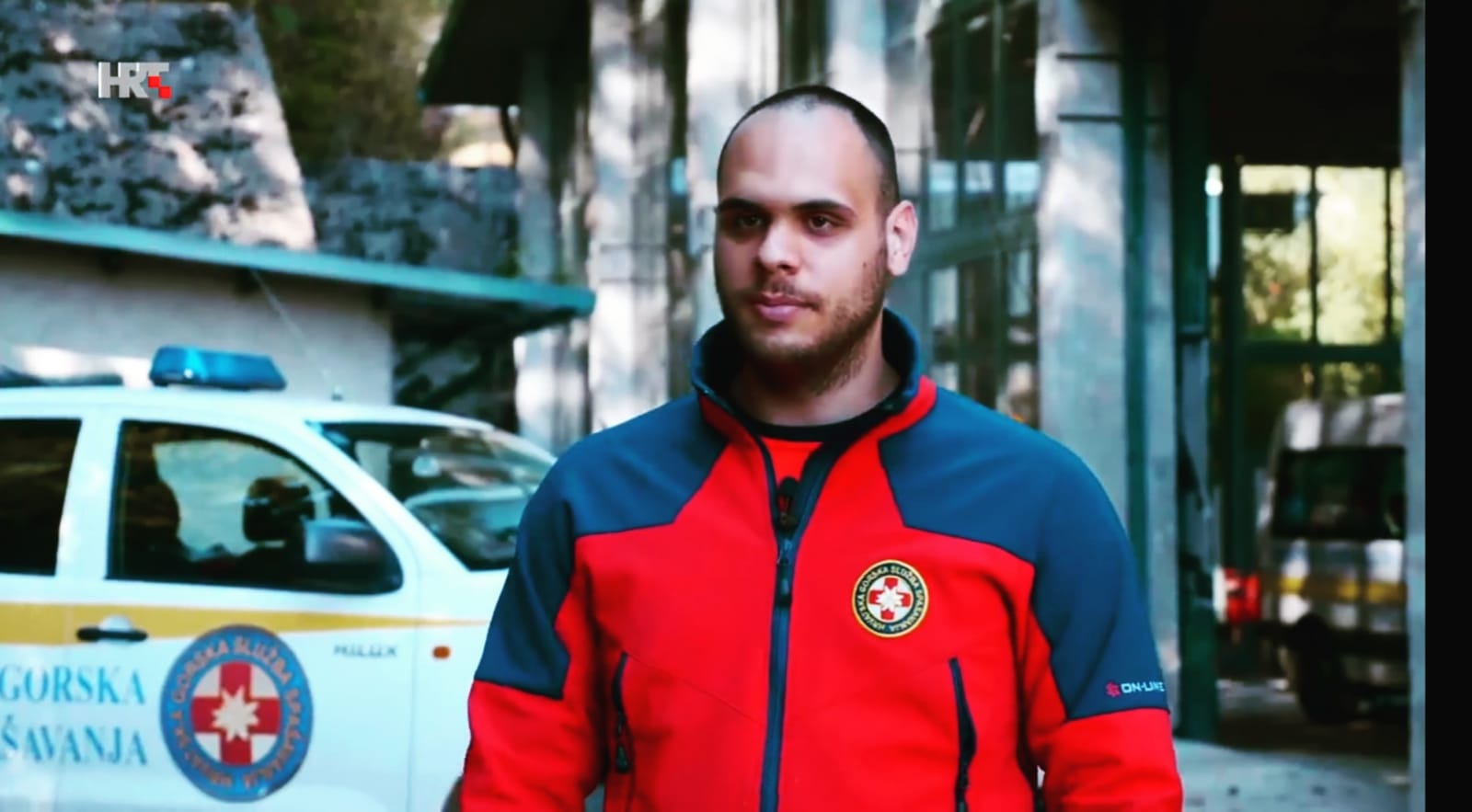
Petar Prpić, firefighter and volunteer for HGSS The Croatian Mountain Rescue Service
My name is Petar Prpić, I'm 25 years old and I'm from Hrvatska Kostajnica, just on the Croatian-Bosnian border. My station is in Novska. In my full-time job I'm a professional firefighter. I guess I have two dangerous jobs. Well, one job and one hobby.
I've always been interested in the outdoors – mountaineering, hiking, canoeing. But, that's not why I joined HGSS The Croatian Mountain Rescue Service. I just wanted to help people. I don't know, I guess it's just something in me.
We have a lot of rivers in our area. During the times of flood, we get a lot of call-outs. Our part of the country has a high percentage of elderly people in the population. A lot of them live in small villages, on the edge of the forest. We get a lot of call-outs for searches. Especially in the autumn when people go out looking for chestnuts or mushrooms. But, like all the stations in Croatia, we are here year-round if there are any actions in other parts of the country that need us.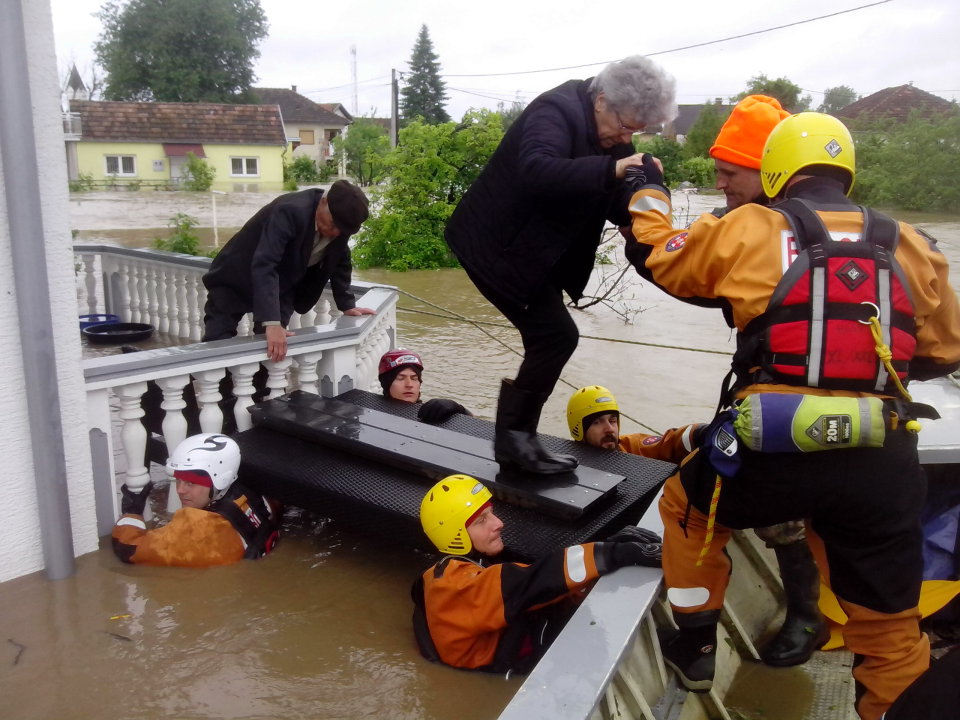
In some areas, HGSS The Croatian Mountain Rescue Service are frequently called out in response to flooding. This picture shows HGSS members on operation during the 2014 floods. In that year, flooding across the whole region was so bad that HGSS members operated not only in Croatia, but also donated their services to neighbouring Bosnia and Serbia © HGSS The Croatian Mountain Rescue Service
I was just on the search in Biokovo. The head of service called me and asked me to go. I first had to get some free days from my job. I called my boss, Zvonimir Ljubičić, chief of the fire department. He's great, very understanding, and he gave me permission. Two years ago I was called to Rab. Very hard operation, very difficult terrain.
Late last summer, we were called out to look for an older man near Glina. It was around 11 o'clock in the evening. He'd gone to look for mushrooms in the afternoon and never came back. Police were there and they sent for us.
The man had a cell phone on him, but there was no signal. There was no location given off the phone. We were a team of four, split into two teams. We went up into the woods above Glina and concentrated our search on areas where we could see there was no telephone signal on our phones. We were yelling in the dark. After an hour of search, someone answered. He'd been missing since 2pm. We found him at 2am. He was just lying there, uninjured but unwell, unable to move.
The reason it sticks in my mind is that the next day, in the morning, his daughter called me. She was so thankful, so emotional. For sure we saved his life. None of the other emergency services who were present could find him. It was down to us. We finished the operation at about 6am and then all four of us had to go immediately to our regular jobs.
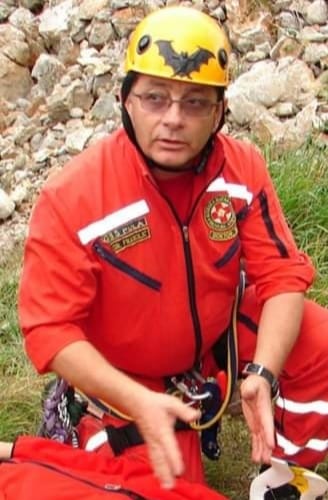
Mario Franolić, physician, ex-commando and volunteer for HGSS The Croatian Mountain Rescue Service
My name is Mario Franolić and I'm 60 years old. I'm the chief of the mountain rescue service in Istria. I travel throughout Croatia because I'm also an instructor for the medical commission of HGSS. I was born on island Krk. I'm based in Pula although I work in Rijeka. I travel a lot between the two. I've been with HGSS The Croatian Mountain Rescue Service for 18 years.
In my day job, I'm a physician. I am a senior mentor at the Institute for Underwater and Hyperbaric Medecine in the Clinical Hospital Rijeka. I'm an expert in my field of emergency medecine. I've been doing it for almost 30 years.
When I was young, I trained to be a physician in Belgrade. It was then the best medical faculty in Yugoslavia. At the same time, I also started spelunking (cave exploration). I've been doing it since 1978. Later, I was a physician in the military underwater commando unit. I lived in Austria for five years, but when I came to Pula, they were just starting the HGSS The Croatian Mountain Rescue Service station here. They asked me for help because they didn't have any medical professional on the team. I accepted. It would be a waste not to use all these skills I have.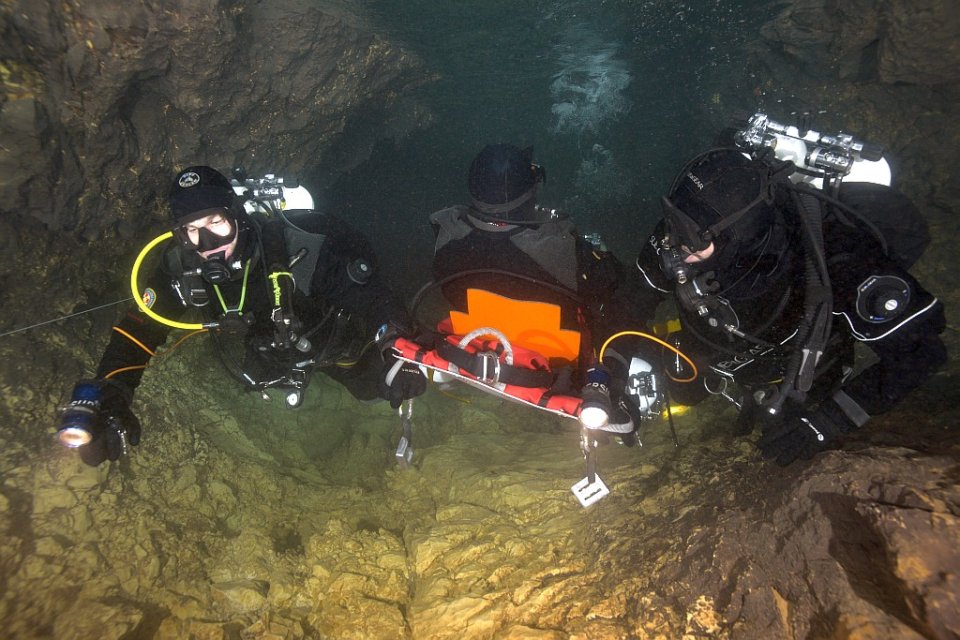
Specialist teams from HGSS are trained in underwater rescue from caves. Such caves exist all over Croatia in the karst rock, and also on some islands © HGSS The Croatian Mountain Rescue Service
Sometimes, our status as volunteers can give us problems. Although we have official duties, we are more like an NGO than something like the police. There can be legal implications. I remember one situation, very acute because a paraglider fell from the sky. None of his colleagues saw him fall. Paragliders go into the air together, but then they each branch off to do their own thing.
We had no idea about the location. We started from the last point of sighting, knowing that it could be very far from the place where he actually fell. But, we had to start somewhere. We had one mobile phone signal direction. But, you need three in order to locate someone. We only had a line on the map.
In the past, HGSS The Croatian Mountain Rescue Service sometimes had difficulties because the telephone companies wouldn't give us the information we needed in order to triangulate the position of a missing person. They would only give it to the police. But, it's a race against time. We searched for this man all day and all night. In the morning, some Croatian paragliders made private contact with a guy from the phone company. They begged him to release the information we needed. Although he could lose his job, giving such information to private citizens, he did it.
We found the man about 150 metres from where we were. Sadly, he was already dead. It was very small comfort to see that he had died instantly, on impact. It's unbearable when you reach someone you could have saved if only you had got there quicker, especially in an instance such as this, where we were hindered by a lack of information that was available. I think it moves more quickly now, but still we have to go through the police.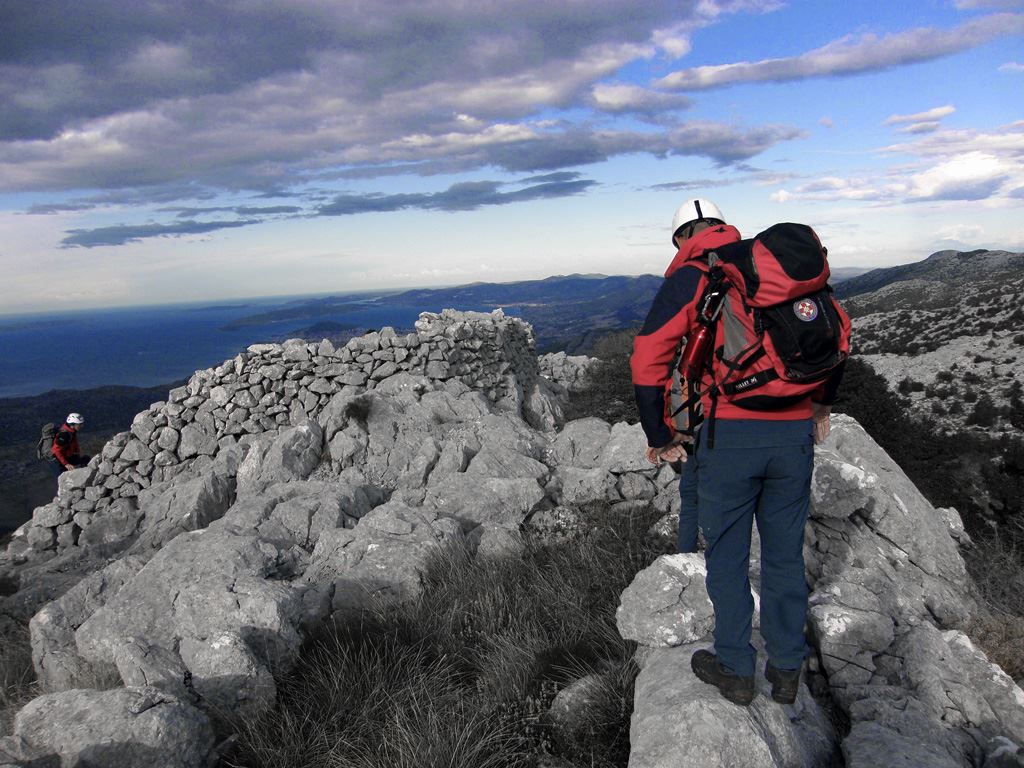
© HGSS The Croatian Mountain Rescue Service
One of the most emotional operations I went on was around five years ago, the rescue of a young girl - maybe two and a half to three years old – who got lost in the woods in a small place in central Istria. She chased into the forest after some dogs around 10 or 11 in the morning. The family saw immediately that she had disappeared and started to search. About two hours later, we were called out. It was impossible for the family to find her.
About 300 people came – my station, the Rijeka station, hunters, firemen, police and volunteers. In such an operation, the police are the lead service. But, 99% of the time they leave the organisation of the search to HGSS The Croatian Mountain Rescue Service. We are the only organisation who is very well educated in organising searches. When other people do searches, they use intuition. But, people all have different intuition. It can be chaotic. We are highly trained for this. There are procedures, recognised internationally, that we follow. We found her early in the morning, at around 7 o'clock. The dogs were lying on each side of her, giving her warmth.
All photos courtesy volunteers and HGSS The Croatian Mountain Rescue Service
Opatija Mayor Urges Croatian Government, Headquarters to Divide Country into Epidemiological Regions
August 15, 2020 - Opatija Mayor, Ivo Dujmic, asked the Croatian Government and National Headquarters to divide Croatia into epidemiological regions as soon as possible. Dujmic believes that the counties of Istria and Primorje-Gorski Kotar should not bear the consequences of the unfavorable situation in Split-Dalmatia County.
We have transmitted his post on Facebook in its entirety:
"Urgently divide Croatia into epidemiological regions"
"This way, I must express my dissatisfaction with the current situation, i.e., that the Civil Protection Headquarters is avoiding dividing Croatia into regions and thus save the tourist season in those counties that have a favorable epidemiological situation.
I am primarily thinking of Primorje-Gorski Kotar and Istria counties, which have, by far, the most tourists in Croatia and, in addition, have a very favorable situation with the coronavirus. We must keep these good tourist figures, that is, take care of the existence of many families, entrepreneurs who depend on tourism, but also the budget of our cities, counties and the state itself.
I don't even have to say how many problems the citizens of Primorje-Gorski Kotar and Istria counties have who work in neighboring countries and go to Italy or Slovenia daily or weekly. Why do the new measures of the Headquarters apply to the whole of Croatia, i.e., why do our entrepreneurs have to bear the consequences of the bad epidemiological situation in Split-Dalmatia County?!
Therefore, I ask the Government and the Civil Protection Headquarters of the Republic of Croatia to urgently divide Croatia into epidemiological regions, i.e., green, orange and red regions, which would be a clear message to other countries, especially those on which our tourism depends. I also ask that the measures be determined by regions and not linearly for all counties.
We don't have time anymore; decisions must be made as soon as possible!”
For the latest travel info, bookmark our main travel info article, which is updated daily.
Read the Croatian Travel Update in your language - now available in 24 languages!
Istria Urges Croatian Government to Respond to Italy's Decision on COVID Testing
ZAGREB, Aug 14, 2020 - Istria County and Istrian cities called on the Croatian government on Friday to immediately send a request to the Italian government to carry out the obligation to test all arrivals from Croatia selectively, in accordance with the real epidemiological situation in different parts of Croatia.
They called for the same request to also be sent to the Slovenian government, which had announced that entire Croatia could be put on the red list of epidemiologically unsafe countries.
"We are sure that you yourself understand that such a unilateral move by Italy, as well as announcements from Slovenia, are seriously jeopardising the tourist season, especially at a time when tourist arrivals are most numerous and a large proportion of guests are from Italy and Slovenia themselves," representatives of Istria county and cities said.
They underscored that Istria was keeping the health situation under control, just as it had been in the previous months, and that it had great results in tourism and the biggest portion of Croatia's overall tourism turnover, as a result of great effort and responsibility of all Istrians.
"Our county is safe health-wise and successful in tourism - we call on you to enable it to stay that way," Istrian officials said, noting that the state budget, which had already suffered a massive blow because of the crisis caused by the coronavirus, also depends on the results of the tourist season.
They, therefore, request that at the moment when Dalmatia's epidemiological situation has significantly worse, it should be made possible for Istria, as a safe destination, to save Croatia's this year's tourism results.
A prompt reaction by the government, the Foreign and European Affairs Ministry and the Tourism Ministry to Italy's decision and Slovenia's announcement has also been requested by the Istrian Democratic Party (IDS).
"Italy's decisions has far-reaching negative consequences for the Croatian economy and requires maximum engagement of all relevant institutions. Croatia must use all available diplomatic channels, extremely well-developed bilateral relations with Italy and diplomatic channels at the EU level to revise Italy's decision," IDS said.
Big Blow to Croatian Tourism: Italians Canceling Reservations on Coast
August 14, 2020 - Italy's restriction on travelers returning from Croatia has already proven to be a big blow to Croatian tourism.
Italy yesterday restricted all travelers returning from Croatia, Greece, Malta and Spain. Namely, travelers need to prove that they have been tested in the last 72 hours and that they are negative for the coronavirus. If they can’t, they have to commit to being tested within 48 hours in Italy. This new measure, of course, is no friend of Croatian tourism.
Index.hr reports that the news caused concern among Italian tourists who are canceling their trips to Croatia.
"This is a decision made yesterday, so we are already recording the cancellations of the reservations themselves," camp director Massimo Piutti told Nova TV.
"We've been receiving calls all morning from Italian tourists who are upset about this decision. However, they still show interest in Croatia and want to come to Croatia," says Viviana Vukelic, director of the Croatian National Tourist Board in Italy.
And for those who are already there, the decision of their government is not clear.
Overnight holidays have become more complicated for Italian tourists who are vacationing in Croatia, and there are currently about 46,000 of them.
"I'm surprised because I think we have too many cases in Italy. I don't know now exactly how it is in Croatia, but I think you have had relatively few cases compared to Italy," one Italian woman told Nova TV.
Boris Zgomba, president of the Association of Travel Agencies at the Croatian Chamber of Commerce, says he does not understand why Italy implemented such a move.
About 30,000 Italian tourists are currently vacationing in Istria and Kvarner, which is two-thirds of their total number in the country. They are worried about the new information, but they don't know anything yet.
"We don't know anything yet. We don't understand, if we don't get tested, will anything happen to us? Is it my responsibility, will I report to the hospital? At least they should have told us that before, not now that we're here for three days now," one tourist told HRT.
The Chief of the Civil Protection Headquarters of Istria County, Dino Kozlevac, said that the decision was disappointing.
"I don't think we are so bad in epidemiological terms, especially since they know which regions in Croatia are more vulnerable, which have fewer cases. Istria is a completely safe region for them, both Primorje-Gorski Kotar and most of the entire coast. Therefore, it saddens us because it will complicate the whole situation around tourism and is definitely not good," said Kozlevac for HRT's show Regionalni Dnevnik, adding that there must be some other reasons for that decision.
"I guess it is a tourist decision. Croatia is a hit this season; there is a lot of tourism, we are fighting the virus in parallel, successfully, less successfully, successfully again. Therefore, there will probably be some reason," said Kozlevac.
For the latest travel info, bookmark our main travel info article, which is updated daily.
Read the Croatian Travel Update in your language - now available in 24 languages!


